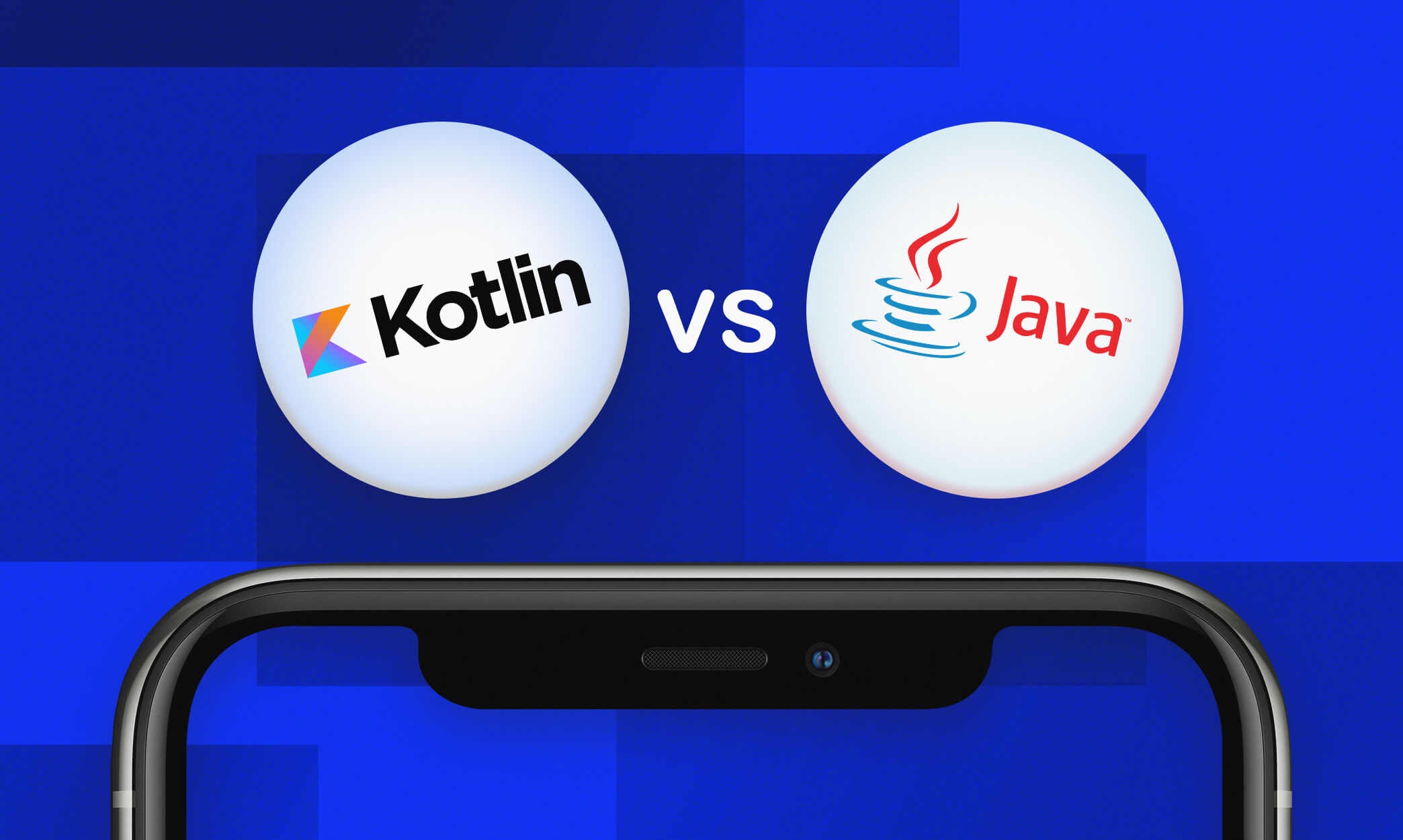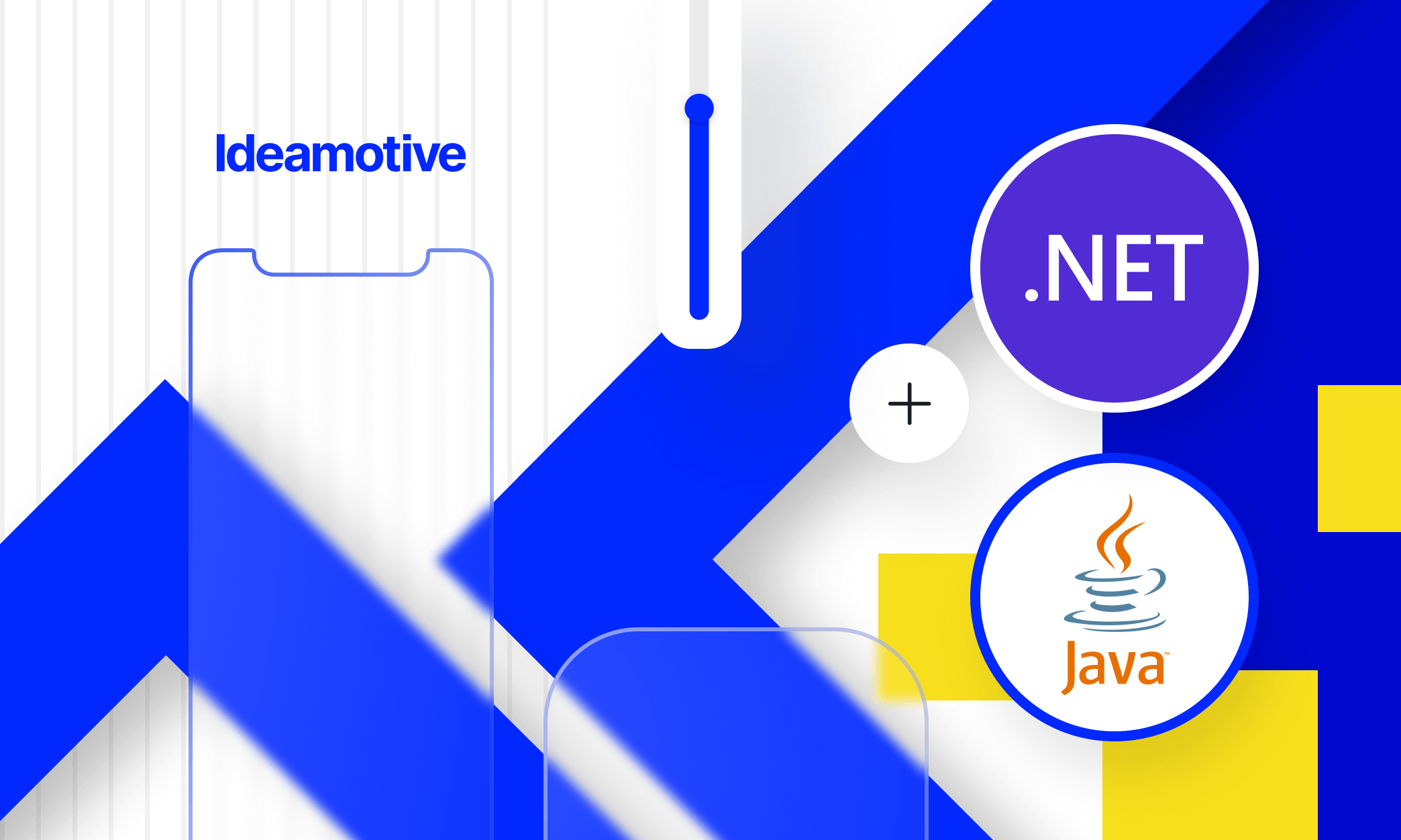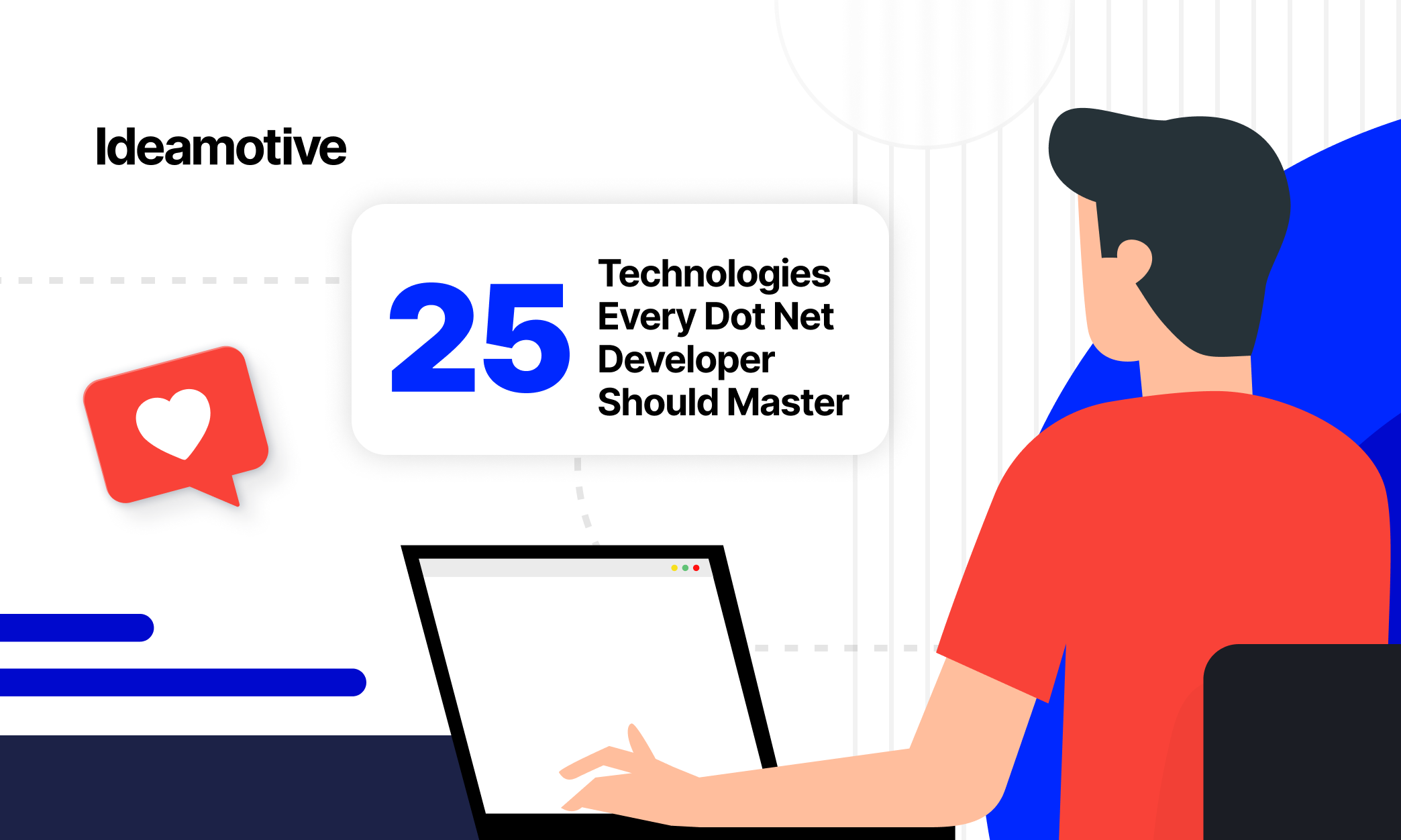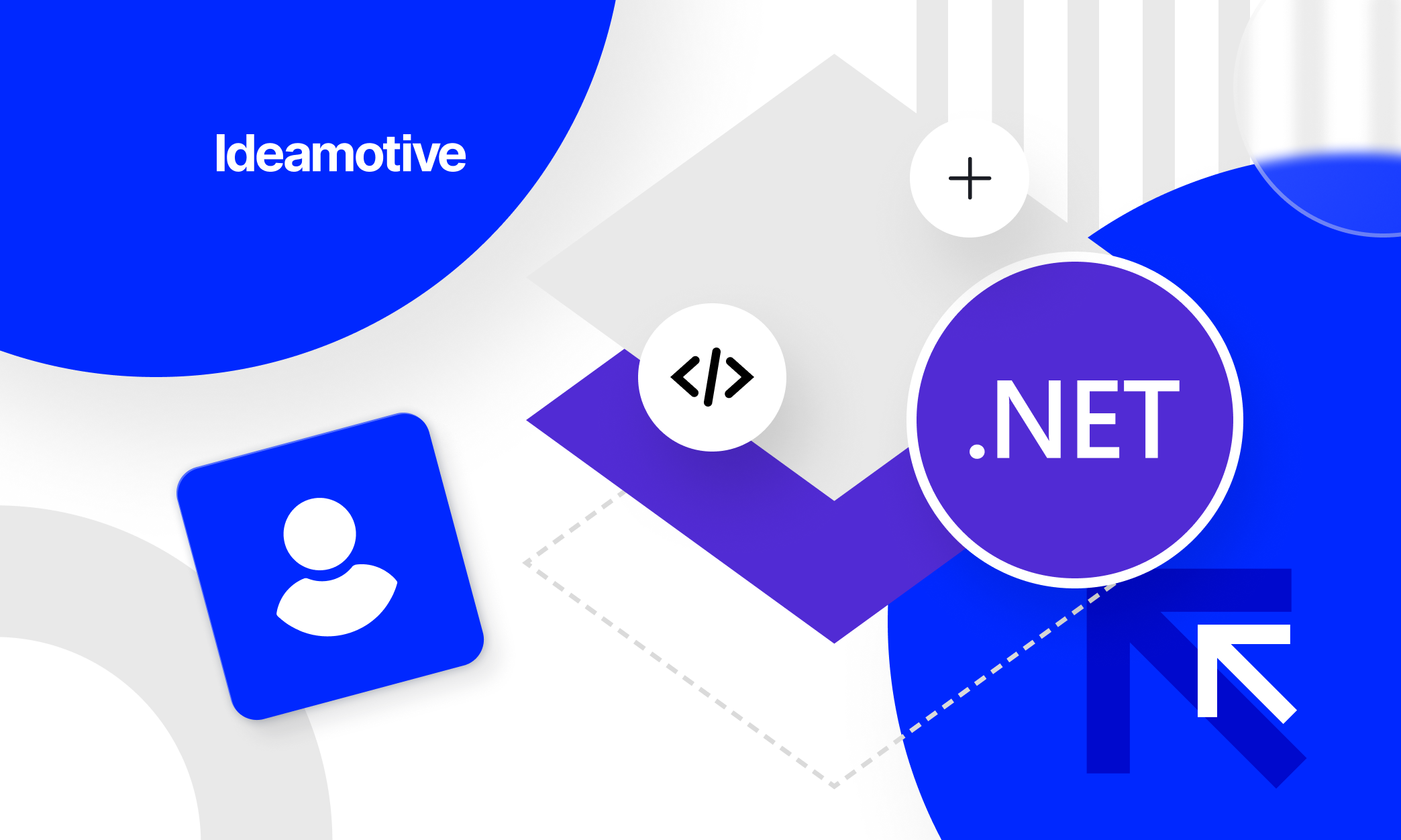The Business Side of .NET Development
For companies and teams of all sizes
Why .NET?
Applications are becoming an important part of almost all industries. As a result, companies can now get their customized business application at a comparatively lower price.
According to Enlyft, Microsoft .NET has about 7.2% of the market share in the software framework category.
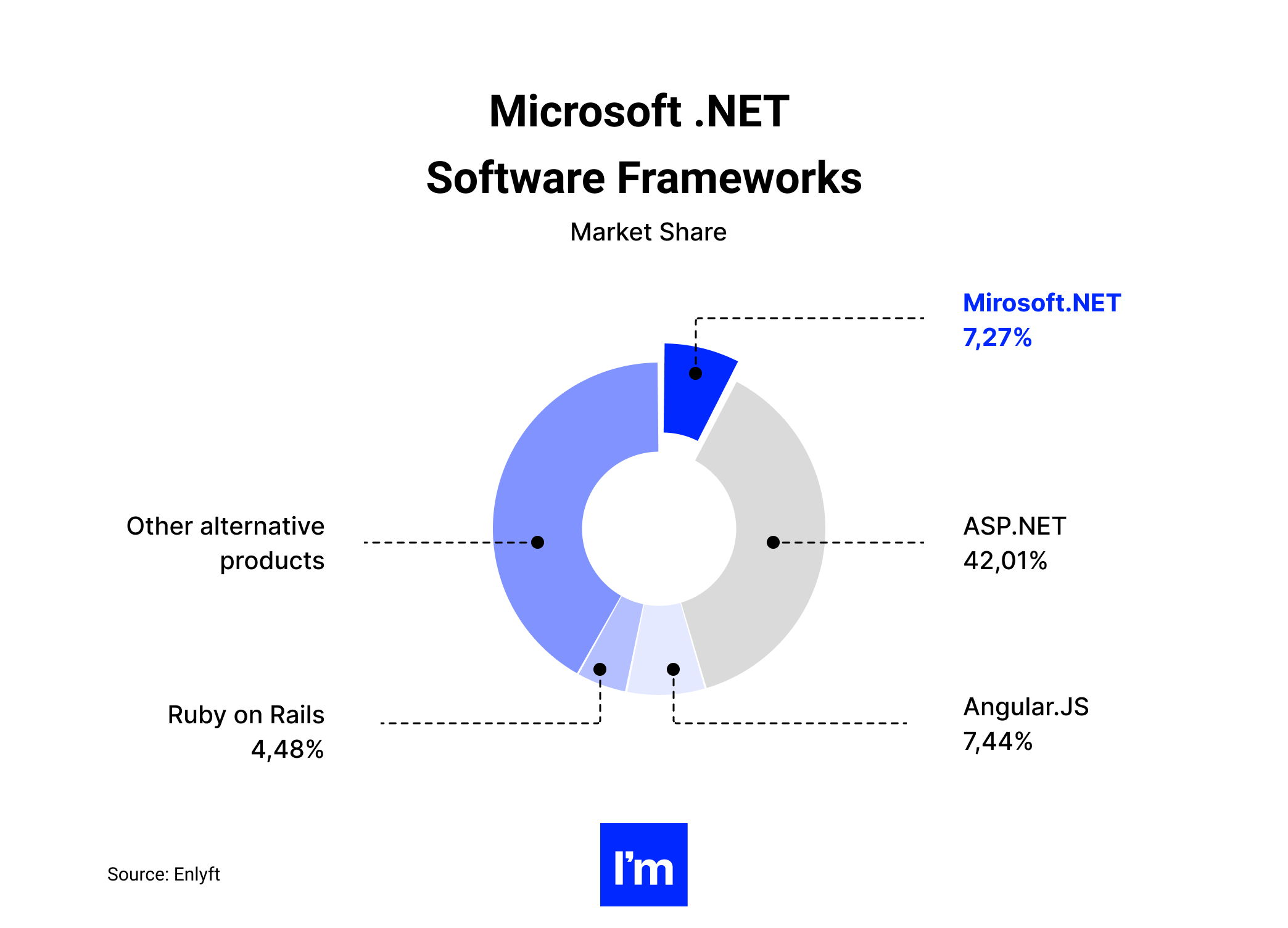
If you're looking for a well-established method of running apps on both mobile and desktop platforms, ASP.NET and .NET development can work for your project.
With multiple frameworks to choose from that work seamlessly with each other, your imagination is the limit. Running your website or mobile application using .NET software development gives you resources that other systems don't have.
Thanks to a wide range of coding and knowledge repositories and server-side compatibility, .NET development can be a great option for your next venture.
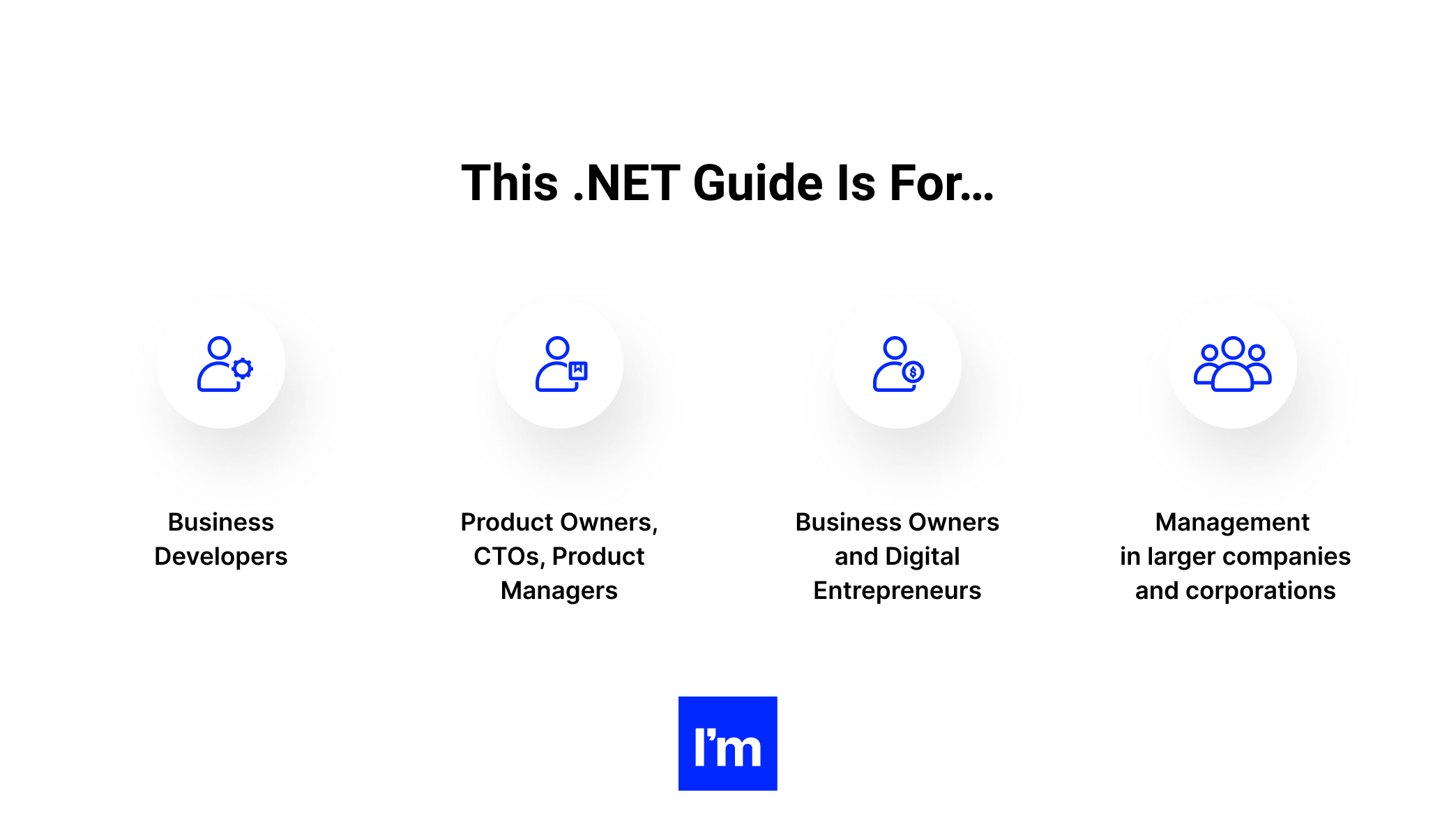
This page answers all the questions a business can only think of. Here, you won’t find coding tips or hints on enhancing your product. This guide is dedicated to numbers, building perspectives, risks, and issues you will face when choosing .NET development.
So, if you are the someone on the list below, this guide is for you:
- Business developers. Do you identify and research potential customers? Develop and maintain relationships with clients? Coordinate with sales teams to develop mutually beneficial offers? Discuss contract terms with clients and communicate with stakeholders? Bookmark this page!
- Product owners, CTOs, product managers. Do you represent the voice of the customer and the company's strategy? Maybe you support the development ROI? Don’t leave this guide until the last sentence!
- Business owners and digital entrepreneurs. Do you use the possibilities, reach, and power of the internet to offer products and services for profit? Our guide definitely has something to offer you!
- Management in larger companies and corporations. So you develop goals, strategic plans, company policies and make decisions about the direction of the business, right? Don’t forget to share this page with other members of the board!
Couldn’t find yourself on the list? Don’t worry! Our business guide is for everyone who wants to make the most of their idea!
What you will learn from this guide:
- Basic .NET info
- An overview of the types of products and fields where .NET can be used
- The .NET technology landscape: frameworks, libraries, similar technologies
- Most commonly used alternatives to .NET and ASP.NET
- Pros and cons of .NET development
- Steps to hire a decent dot NET developer
- .NET development case studies and best use cases
- The state of the .NET for the beginning of 2022.
And a ton of other related and useful info!
Want to get started but can’t read this guide online right now? No worries! Download the PDF version of this page.
GET THE EBOOK VERSION OF THIS GUIDE
The guide breaks into snackable sections so you can easily navigate the content and move directly to the topic you need.
But if you still don’t have the time to go through them now, we’ve got your back! Here’s the pdf version for you.
By clicking “Get the e-book” you consent to processing your data by Ideamotive Sp. z o. o. for marketing purposes, including email marketing.
Table of Contents
01 What is .NET?
.NET is a software development environment and ecosystem developed and supported by Microsoft to simplify the development of desktop and web applications. It is a popular free platform that is currently used for many different types of applications as it provides a programming environment for most of the stages of software development.
.NET is best suited for companies looking for a wide range of features such as web services, desktop software, and cloud infrastructure support.
What everyone should know about .NET
Microsoft started working on the .NET framework in the late '90s. The idea was to create a platform based on so-called managed code, code that can be executed at runtime. This was necessary to improve the development experience and free engineers from performing security operations, active memory management, and other low-level tasks that C/C++ developers had to tinker with.
The first release of the .NET Framework in 2002 introduced C#, a managed code language with a design similar to C++. The framework itself targets Windows computers and servers.
It had WinForms, a GUI library for desktop applications; ASP.NET, a framework for the web; and ADO.NET for data access.
All of these elements were used by the Common Language Runtime (CLR) to compile and execute managed code.
To combine the different functions, .NET offered a Framework Class Library (FCL), which included a Base Class Library (BCL), a Networking Library, a Number Library, and others.
Since then, the framework has gone through several iterations covering runtime updates, new desktop graphical systems (WPF), APIs for service-oriented applications (WCF), and more.
In 2014, Microsoft announced a radical change in the way .NET operates with the introduction of .NET Core, a new cross-platform, cloud-friendly version of the open-source framework.
.NET Core was released in 2016, becoming the primary technology to consider when developing new .NET projects.
Gradually, Microsoft began porting existing services to work with Core. Some that did not receive official ports, such as Windows Communication Foundation (WCF), have been replaced with community-developed alternatives.
Additionally, in 2016, Microsoft acquired Xamarin, formerly proprietary technology for cross-platform mobile development, making it open source as well.

Microsoft continued to move towards "transparency between the product development team and the community" and launched the Windows Presentation Foundation (WPF), Windows Forms, and WinUI in December 2018.
Modern .NET
But that's not all. In 2019, the company released a major update that united the entire ecosystem: all .NET products were merged into the .NET 5 development platform. This means that developers will be able to create applications for Windows, Linux, macOS, iOS, watchOS, Android, tvOS or use WebAssembly with just one .NET.
The platform will ship with new APIs, language features, and runtime capabilities. In addition, .NET 5 will include ASP.NET Core, Xamarin, Entity Framework Core, WPF, WinForms, and ML.NET.
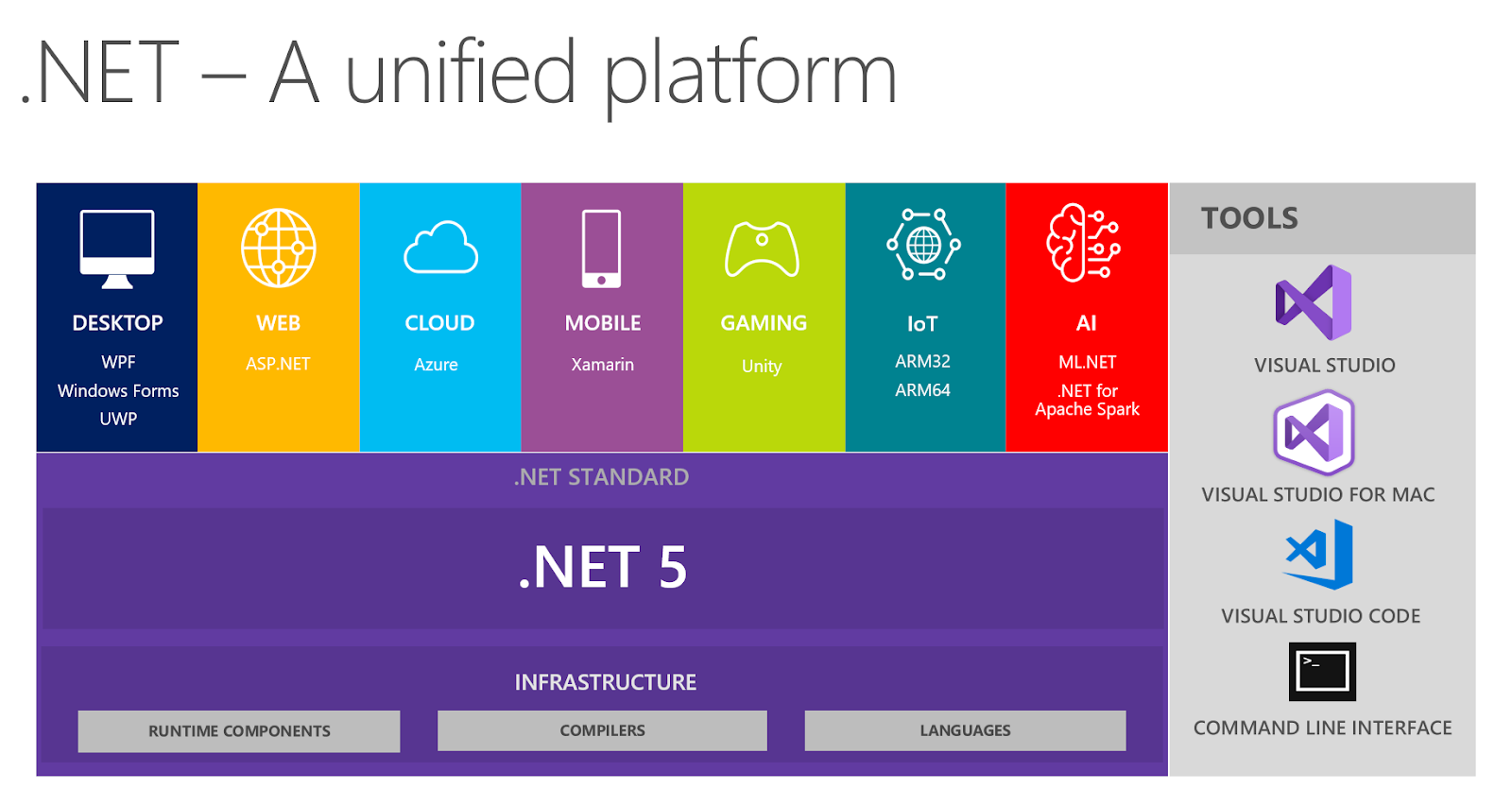
With these changes, for now, a practitioner of .NET can work with three separate branches of the Microsoft platform:
- .NET Framework - still dominant in business,
- .NET Core - a new framework,
- Xamarin for mobile.
In addition, Microsoft offered the .NET Standard library to connect all three APIs and ultimately make life easier for engineers.
Today, .NET comes in four flavors:
- .NET Framework,
- .NET Core,
- Xamarin,
- Universal Windows Platform (UWP).
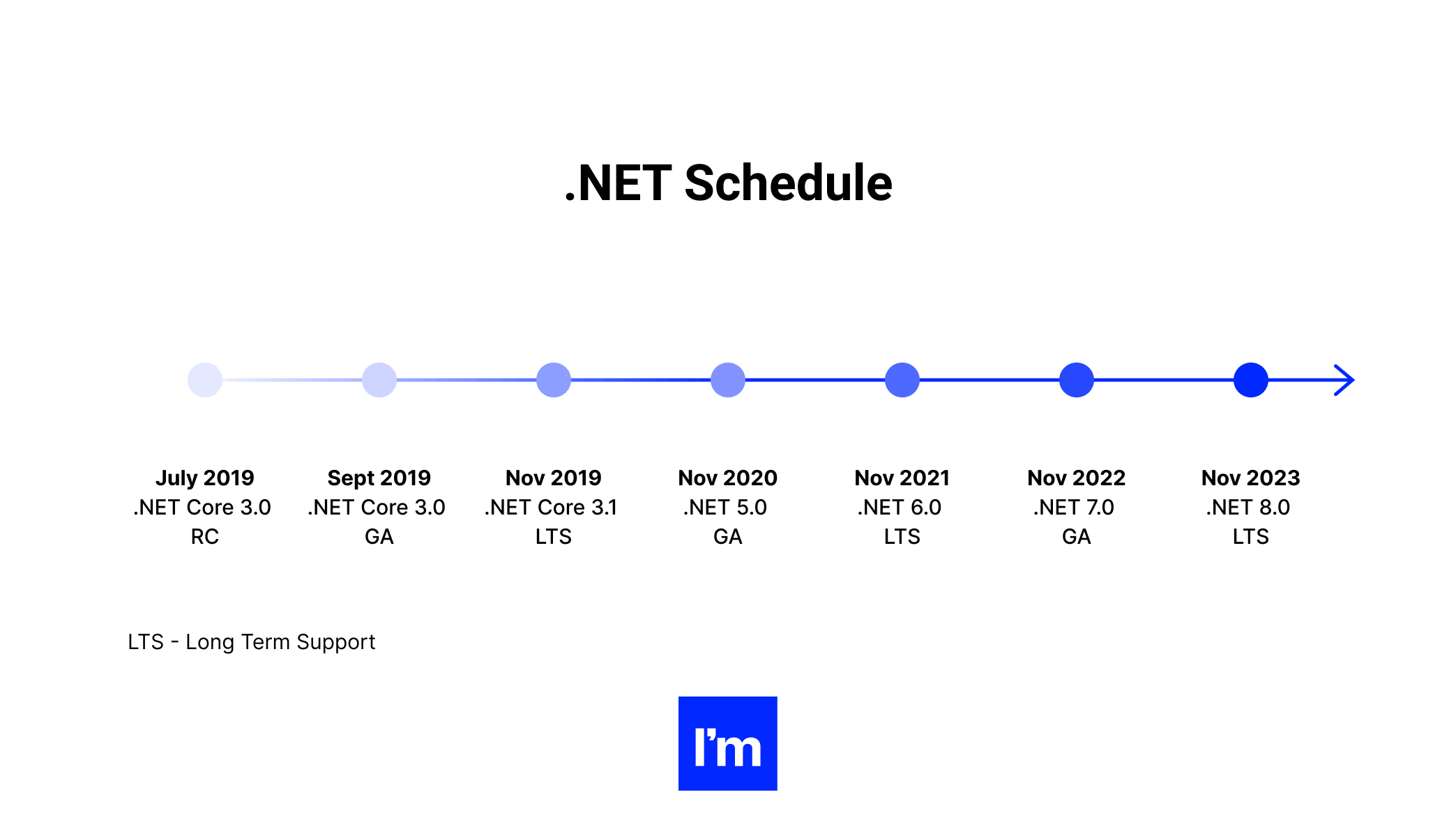
These combined implementations are referred to as the .NET development framework. Each of them contains frameworks and libraries for building different applications.
(Pictures’ source - Introducing .NET 5 - .NET Blog)
02 What can you do with .NET? Who is .NET for?
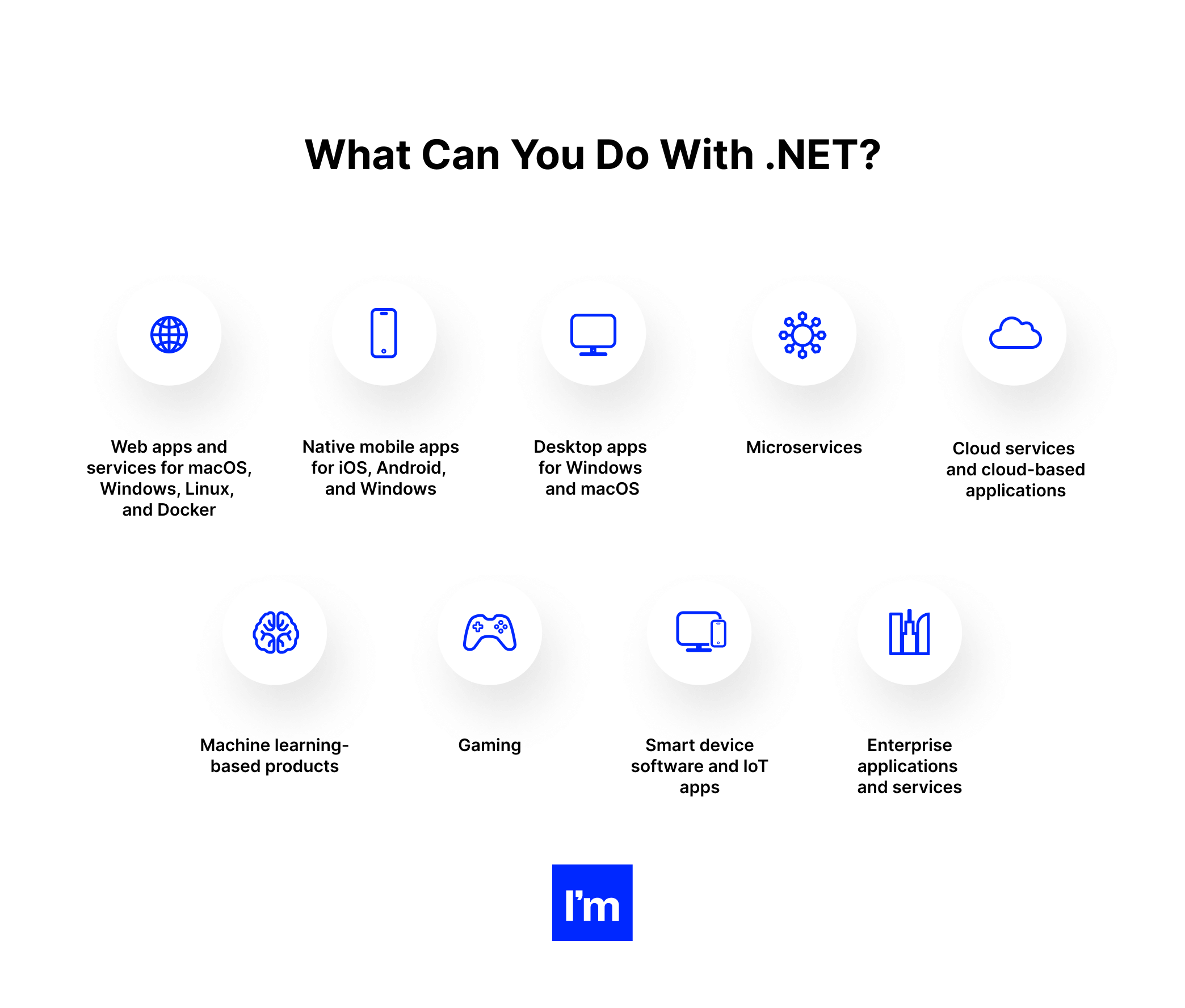
Programming languages and frameworks are created to solve specific problems and develop appropriate software products. .NET also has its own unique features.
It is noteworthy that the range of products developed by .NET developers is very wide. Just browse the list of companies using .NET.
They represent a wide variety of industries, from finance and trade to science and sociology.
In general, the wide variety of software products developed for .NET can be grouped as follows:
Web apps and services for macOS, Windows, Linux, and Docker
Perhaps the most widely used group of applications written with .NET. The great thing about web applications is that they run in a web browser.
Web applications vary in complexity. Building a small, one-page website with images and links is easy. However, developing a complex web application will take a lot of effort.
A prime example of an application with a simple interface and a complex backend is the Stack Overflow website, which is known to every developer.
Writing a .NET web application requires knowledge of C# and the ASP.NET MVC framework.
It is also important to understand what a client or server is, how protocols such as HTTP, REST, and JavaScript are used, and the difference between an interface and a server.
These days, this type of development requires knowledge of domains, web hosting services, plans, and some understanding of cloud technologies like MS Azure, Amazon Web Services, Yandex Cloud, and others.
Native mobile apps for iOS, Android, and Windows
Today, companies build applications that can be used easily and have great performance on a computer, laptop, or mobile phone. This helps when creating a compatible application that can be used across multiple platforms.
Using .NET provides great features to help programmers develop an application that syncs across all platforms. It is also used for developing desktop applications. Many organizations chose to work in .NET just because of this feature.
Xamarin is a tool used to develop native mobile apps using C#. With .NET Core and Xamarin.Forms, you can write an app and publish it to the App Store or Google Play to make it available to anyone with a smartphone or tablet.
Desktop apps for Windows and macOS
Desktop applications can also be developed with .NET. These are products that run on end-user personal computers and mobile devices.
Several components of the Windows operating system are designed using .NET. Among them are Notepad and Calculator. However, there are also many .NET applications written by individual developers, and some of them are available on this website.
More sophisticated products are also being developed. For example, there are NinjaTrader and Tradesignal for trading and Microsoft Power BI for business intelligence.
The latter visualizes information from any source and makes it faster and easier to process lots of data.
.NET provides four main technologies for building desktop applications: WPF, Windows Forms, UWP, and Xamarin. Typically, desktop client applications are developed using Windows Presentation Foundation (WPF) or Windows Forms technologies. You can use them to create complex applications for users' desktop computers.
Microservices
ASP.NET, the web framework for .NET, makes it easy to create APIs that become your microservices. ASP.NET has built-in support for developing and deploying your microservices using Docker containers.
.NET includes APIs that make it easy to use microservices from any application you create.
Cloud services and cloud-based applications
The cloud has become the primary destination for software applications. Cloud-native apps are designed to be built, tested, and deployed in the cloud. Cloud applications are modern, high-performance, automated, and highly scalable. The key features of cloud applications are modern design, the use of microservices and containers, helpdesks, and automation.
.NET enables you to build fast, modern, and scalable cloud applications across all major cloud platforms.
If you haven't chosen the cloud yet, we recommend Azure. Azure is the best cloud for .NET developers because it was built for .NET developers.
Hundreds of Azure products work natively with .NET and are integrated with Visual Studio developer tools.
What’s more, your .NET development company can use project templates to get you up and running faster, as well as powerful debugging, publishing, and CI/CD tools to increase productivity in developing, deploying, and monitoring cloud applications.
Machine learning-based products (vision algorithms, speech processing, predictive models)
A challenge for many organizations is seamlessly bringing machine learning models to production due to inconsistencies between technologies and frameworks.
ML.NET is Microsoft's answer to this problem. It is an open-source, cross-platform machine learning framework that allows .NET developers to build, train, and use their own machine learning models while remaining in the .NET ecosystem.
With ML.NET, you can get your own machine learning model up and running in no time.
ML.NET allows you to create world-class AI models and applications based on a variety of use cases. The sky's the limit. Check out this repository which contains many examples, such as:
- Sentiment analysis
- Spam detection
- Fraud detection
- Product/Film Recommendation
- Price forecast
- Sales forecast
- Anomaly detection (credit card fraud)
- Image classification training
- Object detection
Gaming (2D and 3D games for the most popular desktops, phones, and consoles)
.NET works well with Xamarin and Unity, a game engine based on Mono, for developing game apps for mobile and game consoles. Unity is one of the most popular game development tools out there and it supports C# and .NET development and works well with Visual Studio.
Notable games developed with Unity include Inside, Kerbal Space Program, Endless Legend, and even Pokemon Go.
All you need to create a game is to write C# code and use the Mono and Unity framework libraries. It's much easier and faster since you don't need to learn C++. C# code translation is done by Mono and Unity. To get started on your game development journey read Unity: Developing Your First Game with Unity and C#.
Smart device software and IoT apps
The Internet of Things is the field of developing "things" that can interact with each other, the external environment, and the internet. .NET is also applicable here.
It is multi-platform and supports hundreds of sensors, displays, and input devices that can use GPIO, SPI, I2C, PWM, SerialPort, and more. Sensors include the popular DHT temperature and humidity sensors, accelerometers, lights, gas sensors, and more sophisticated hats like GrovePi, Adafruit Seesaw, Sense HAT, RFID modules like PN532, and advanced ones like FT4222.
For example, you can use a Raspberry Pi with Windows 10 IoT Core to control a smart kettle, home lighting systems, self-driving cars, speech recognition systems, and automated dialogue systems like Yandex.Dialogues (in Russian), which are based on ready-made wireframes.
Enterprise applications and services
Enterprise is not an area of product development for end-users, but for business. Such products include information management systems, document management systems, and customer relationship management (CRM) systems.
Enterprise systems are the result of the collaborative development of web applications, desktops, and mobile devices. Although they are versatile to a certain extent, they are designed to meet a specific set of challenges. For example, if a customer is interested in organizing a complex document management system, the MS SharePoint (SharePoint Online) platform may be a suitable solution. When it comes to building a global online marketplace for a large retail company, the Sitecore platform might be a good choice.
If you want to focus on enterprise development, knowledge of C#, .NET, and JavaScript will not be enough. The developer should also be familiar with the tools that the future enterprise product will be based on. For example, to develop a SharePoint-based product, you need to learn about SharePoint components such as workflows, web parts, timer jobs, custom fields, content types, and features.
Types of companies that can leverage .NET
Startups
Dot NET development is exactly what your startup project requires. Beginning products need stable technology, ideally backed by a large company (like Microsoft in our case) and a lot of community support. All of this can be guaranteed by hiring a custom .NET development company.
Moreover, if you need an application that will run on multiple platforms, .NET is a great choice for startups as it covers most platforms, and you can reduce your development effort when extending your desktop or mobile application to other operating systems. In addition, .NET can be used for specific engineering tasks such as gaming (including for Xbox) and augmented reality development (including HoloLens).
Scaleups
Typically, business needs grow and your software must scale with them. .NET provides a scalable environment and allows current applications to be redesigned to meet those growing business needs. That's why scaleups tend to choose ASP.NET development.
Enterprises
Whether .NET is primarily intended for enterprise use is still controversial. But Microsoft guarantees the broadest set of tools for building and cross-integrating enterprise products, both internally and publicly. It also supports a robust mobility ecosystem for enterprises.
03 .NET technology landscape: frameworks, libraries, similar technologies
In the years since .NET was introduced, many languages have been created or adapted for use with .NET. IronLisp was one of them but was eventually replaced by IronScheme. J Sharp was designed to facilitate the transition of Java developers to .NET by enabling them to leverage their existing skills. The last stable release was in 2007.
However, given the tremendous amount of work that has gone into all of the projects to bring the language into .NET, we have a wide variety of languages to choose from today. In this section, we will take a look at some of the popular languages.
 C++ is a compiled, statically typed general-purpose programming language.
C++ is a compiled, statically typed general-purpose programming language.
The language supports programming paradigms such as procedural programming, object-oriented programming, and universal programming. C++ has a rich standard library that includes common containers and algorithms, I/O, regular expressions, multithreading support, and other functions.
C++ combines the properties of high and low-level languages. Compared to its predecessor, the C language, the most attention is paid to support for object-oriented and general-purpose programming.
 For many, this is the primary language of .NET. C# is a preeminent application development language. In addition, it is used actively to develop Windows desktop apps using WinForms and WPF, UWP apps, and web apps via ASP.NET and ASP.NET Core.
For many, this is the primary language of .NET. C# is a preeminent application development language. In addition, it is used actively to develop Windows desktop apps using WinForms and WPF, UWP apps, and web apps via ASP.NET and ASP.NET Core.
There is a large library of open source products that the hired C# developers can use and/or extend for your .NET applications.
Learn more by reading the following articles:
- .NET vs C#: Similarities, Differences, and Business Applications
- C# vs Java: Which Is Better For Building Your Product?
- C# vs JavaScript: Which Programming Language Is better For Your Needs?
F#

F# is a general-purpose functionality-oriented programming language, supported by a diverse community from around the world that has made it the great language it is today. F# has a cross-platform compiler available from the F# Software Foundation that supports all major operating systems, GPUs, and browsers.
Several sources claim that F# is influenced by C#, Python, Haskell, Scala, and Erlang. However, for developers whose work involves C# heavily, we would say that many of the newest features in C# were actually influenced by F#.
If you're using Visual Studio, Interactive F# is great for testing and executing code while writing it. This has been available for quite some time. This is a feature that other languages are just starting to receive. It's also worth noting that paychecks for capable F# developers tend to be very good. The financial and scientific sectors are often referenced in articles about who is using this technology, though many others also use this language for their core development teams.
If you need more information about F# or want to try it out in a browser, you can find more information here.
For some information on F# Interactive, please click here.

There are many established companies that still regard Visual Basic as one of their main programming languages and have developed extensive systems around it. Easy to read and operate, it is still actively taught in higher education institutions, and Microsoft is doing everything it can to provide continued support for Visual Basic in the same way they do for C#.
It's also worth noting that this language is also supported by .NET Core, so expect this language to remain a cornerstone of the industry for a while.
Windows-only options
If your app is running on a Windows OS, you should use .NET Framework. The .NET Framework, released back in 2002, is the first and oldest implementation of the platform. It includes three main application models — WPF, Windows Forms, ASP.NET Forms — and a base class library.
And what about Java libraries?
WPF is a user interface framework used to create graphical interfaces primarily for desktop client applications on the Windows operating system. WPF leverages the power of Extensible Application Markup Language (XAML).
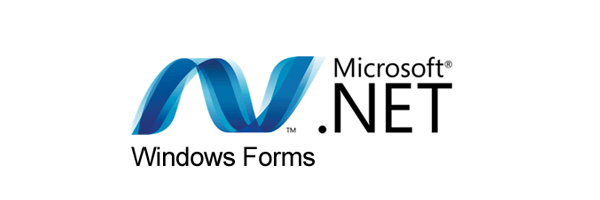
This is a GUI class library in .NET Framework. Windows Forms are used to develop rich graphics desktop applications that are easy to update and deploy.
 While the previous two components are for desktop development, ASP.NET is used for developing dynamic websites and web applications. At its core is the Common Language Runtime (CLR), which gives developers the ability to write ASP.NET code using the various .NET languages we discuss here.
While the previous two components are for desktop development, ASP.NET is used for developing dynamic websites and web applications. At its core is the Common Language Runtime (CLR), which gives developers the ability to write ASP.NET code using the various .NET languages we discuss here.
Base Class Library
BCL provides the most common functionality, such as classes in namespaces, and is the core of the Framework Class Library (FCL), a set of reusable interfaces, classes, and value types that are tightly integrated with the Common Language Runtime (CLR).
The combination of FCL and CLR makes up .NET Framework. The base class library also includes ADO.NET, a data access technology used by developers to access databases.
However, since the .NET Framework only supports Windows devices, there was a need for a cross-platform package.
Cross-platform implementations

.NET Core was released in 2016. It is a cross-platform rework of the .NET Framework. Unlike the old version, engineers can now use the product on Linux and macOS and create applications that are not necessarily tied to the Windows family.
The new system aims to conquer the cloud space as some providers, like Digital Ocean, run Linux. .NET Core is not only cross-platform but different versions of it can be installed at the same time on the same device. .NET Core includes ASP.NET Core and the Universal Windows Platform (UWP).
ASP.NET Core is a rebuild of ASP.NET that is more modular than its predecessor. ASP.NET Core allows you to build a backend for mobile devices, web applications, and services. It is also cross-platform and runs on OS X, Windows, and Linux.
This technology should be used if:
- You are using Docker containers
- You are targeting microservices
- You need scalable, high-performance systems
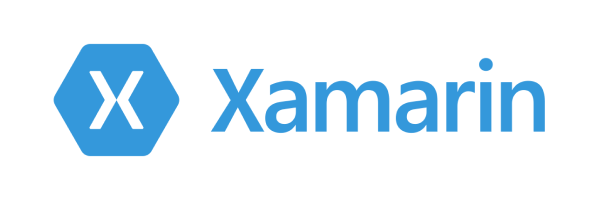
This is used for mobile and Mac products. Xamarin was originally developed independently of Microsoft and was a proprietary product. Microsoft acquired it in 2016 and made it a fully open source .NET platform. Xamarin uses the Mono runtime and a version of the .NET Framework adapted to work with APIs for iOS, Android, and Xamarin.Mac.
All runtimes share a common infrastructure that powers the entire ecosystem. It provides runtime components, languages, and compilers.
Frameworks

.NET uses the Object-Oriented Programming (OOP) language model. This model focuses on objects, rather than "actions" and data, rather than logic. Support for the development of data-driven software applications in the .NET Framework and Core is provided by the Entity Framework.
Entity is an Object-relational mapping tool (ORM, O/RM, and O/R mapping tool) that links .NET Framework object-oriented and relational (SQL) databases. Some engineers feel that Entity Framework is not flexible enough and may not support all available database designs.
It also means that there is a possibility that the Entity Framework may not support new database projects at some point. Another problem is that Microsoft may eventually ditch the framework.
On the other hand, you can always choose another ORM alternative, so this remains a moot point.

UWP provides a common type system, APIs, and app model for all devices running Windows 10. Thus, the Universal Windows Platform allows you to develop universal apps for PCs, tablets, Xbox, Surface Hub, HoloLens, or Internet of Things (IoT) devices.
UWP app developers get access to the Microsoft Store, which charges just 15 percent for subscription-based non-game apps, unlike the Google Play Store and App Store. Other services include the runtime (AppContainer) and extension SDKs for invoking specialized APIs for various devices.
04 Most commonly used alternatives to .NET and ASP.NET
Now let’s see what .NET offers compared to other technologies.
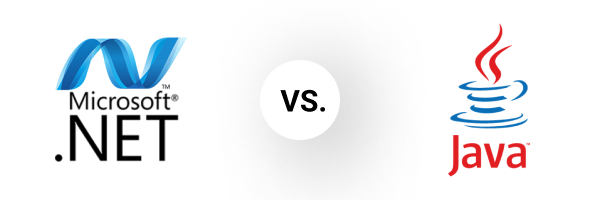
Both technologies are object-oriented and offer enterprise-level development capabilities for virtually every type of application. The modular structure of the code ensures flexibility, easier debugging, and reusability of the code. They are ideal for dealing with complex architectures and high-load systems, and both are used by well-known companies.
Speed of development
While Java offers various streams that make it easier to manage and process instruction sequences, .NET is still the winner in terms of coding speed. .NET is an object-oriented technology made up of various reusable components, which means it will take less time to develop the same application in .NET than in Java.
Performance
For years, there hasn't been a big performance gap between applications built using these technologies, but Microsoft's optimizations and investments have changed the game, creating a huge difference between ASP.NET and Java. It has become incredibly fast.
Versatility
One of the most significant differences between Java and .NET is that Java, especially Java Enterprise Edition, can run on any operating system, while .NET cannot. .NET will only work on different Windows versions. Although there are open source versions of .NET available, this framework is still intended for Windows users.
Cost of development
As per Glassdoor, the median salary for a Java software developer is $91,000, and the median salary for a .NET software developer is $88,500.
Ease of finding developers/developer pool
Let's take a look at Java and .NET usage statistics to understand which technology has become more popular. Data from the Stack Overflow Development Survey, which surveyed over 80,000 developers, found that 34.2% of professionals use .NET and 35.35% use Java.
Who is it for?
These technologies are used in the following ways:
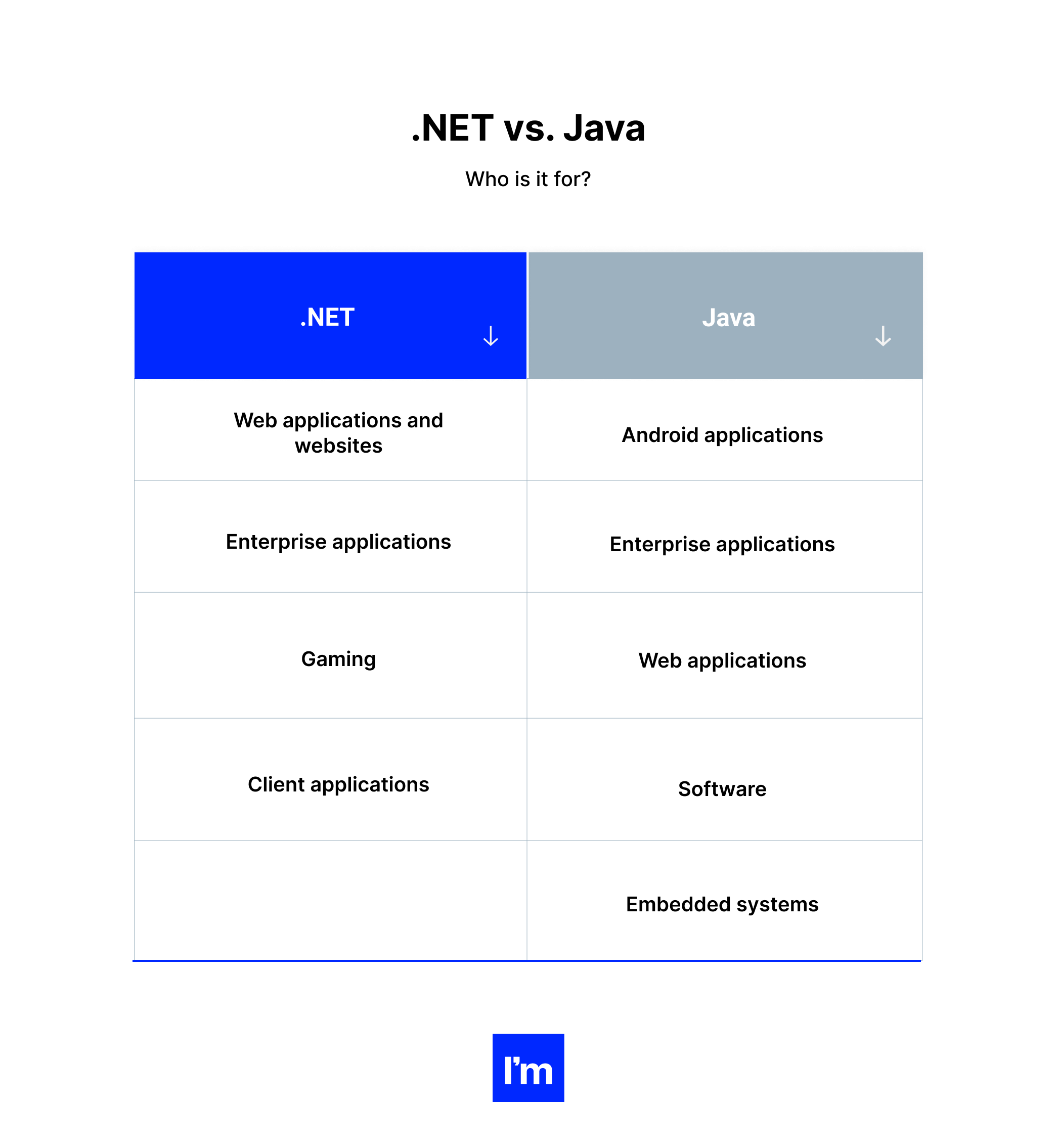
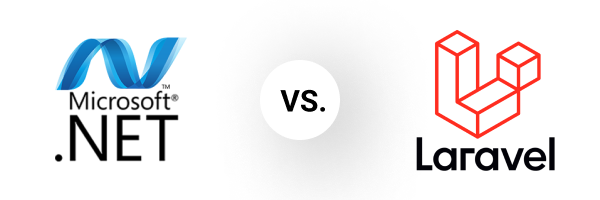
On the one hand, we have PHP, the world's most used and popular technology on the internet, with millions of dedicated PHP developers around the world and its framework Laravel. On the other hand, we have ASP.NET, the Microsoft platform. Sometimes it can be quite difficult to make a clear decision about which technology we should prefer for our application or website development project.
Speed of development
Implementing complex features and functions with ASP.NET requires more code (more lines) than PHP, which increases development time.
In addition, PHP is interpreted on the server, so when functionality changes, no additional action is required to view the changes. On the other hand, ASP.NET needs to be compiled every time the code changes. Again, when using ASP.NET, the development process takes longer than PHP.
Performance
Speed and performance are two advantages you can enjoy over servers when using PHP as opposed to ASP.NET, which has poor performance.
But PHP or other programming languages cannot provide the speed and efficiency of ASP.NET when it comes to compiling and executing code.
Versatility
One of the things a developer loves is freedom!
PHP, unlike ASP.NET, offers you programming freedom!
As you know, PHP is open source and gives you the freedom to do whatever you want. Of course, we agree that there should be some restrictions. When using PHP, you are free to use code editors like Emacs, Notepad++, Bluefish, jEdit, or even the Notepad.
But with ASP.NET, your freedom is limited. You may only be able to use Microsoft Visual Studio.
Cost of development
LAMP (Linux, Apache, MySQL, PHP) is popular with hosting companies. Thus, it has lower monthly hosting costs than Windows hosting.
ASP.NET is free with a Windows purchase. However, there will be licensing costs for MS Windows Server, MS SQL Server, and future upgrades.
So PHP is more cost-effective — it's free and open source. ASP.NET only comes with free web hosting.
Ease of finding developers/developer pool
Both .NET and PHP have a large community and a large pool of developers who post regularly on the forums and are always ready to help you with your project.
Among freelancers (people working remotely), PHP is much more common — mainly due to the ease of learning it. However, in this situation, the ASP.NET programmer has some advantages: having created a site for a client on this platform, they have a high probability of repeated calls (for example, to add functionality to the site) for it. Finding another freelancer working with this platform is quite difficult.
Who is it for?
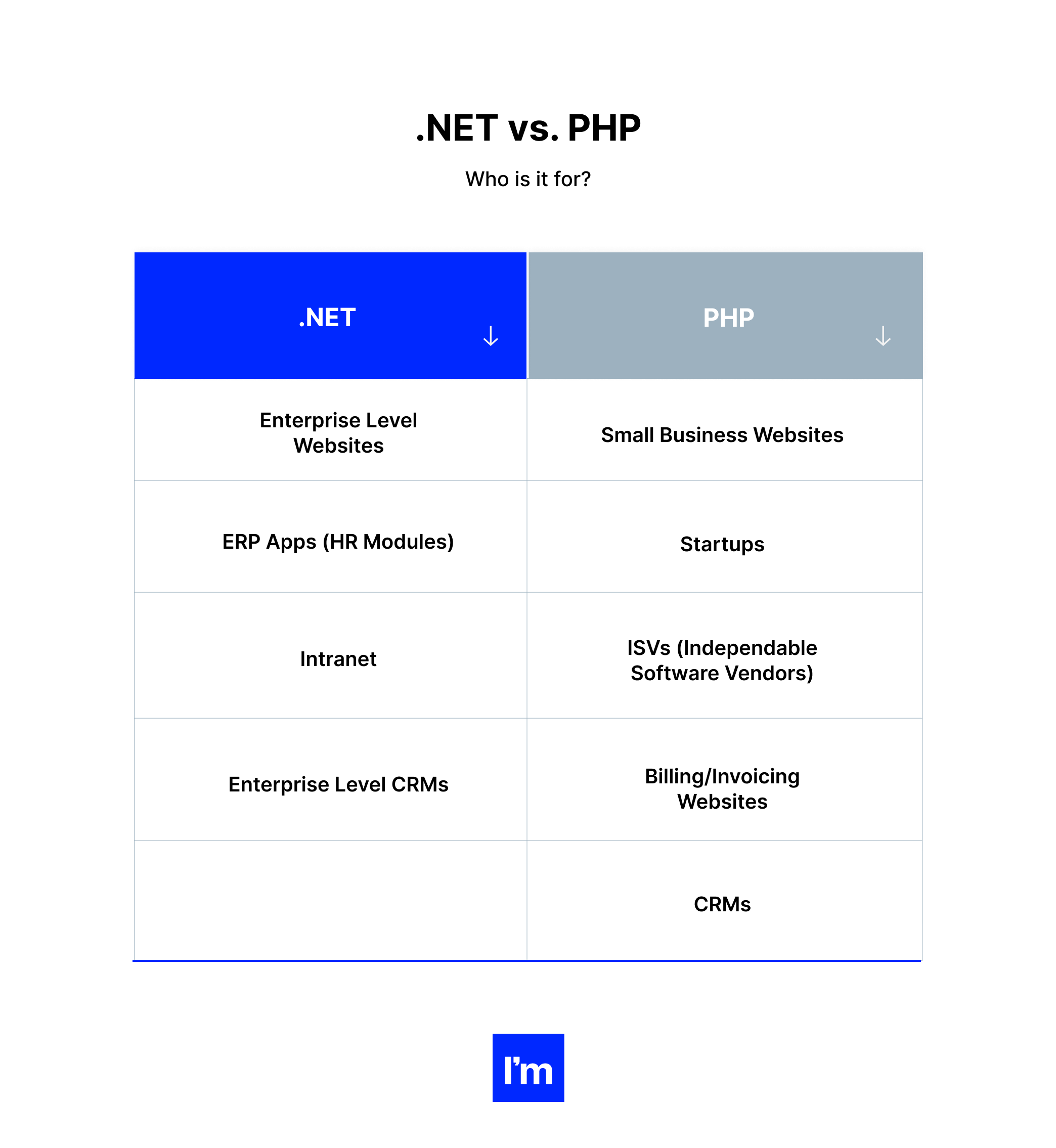
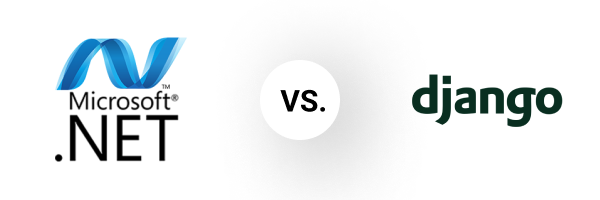
Python is a programming language whereas .NET is a platform that can support multiple languages. Well, it's pretty common among .NET developers to switch to Python and vice versa. Both technologies offer rapid development, quality performance, and smooth learning curves. However, C# is considered a direct competitor to Python. This often makes the choice between the two difficult and troublesome.
Speed of development
As you could learn from our guide, Python is based on the DRY (Don’t Repeat Yourself) principle and readability. It aims to create quality code with minimal effort. Python has a much simpler syntax compared to .NET, it doesn't require the programmer to end each line with a semicolon, has a lot of spaces, and is easy to read.
Performance
When it comes to performance, there is a big difference between .NET and Python. Python is an interpreted language, so its speed is heavily dependent on its interpreter (CPython, PyPy, etc.). Unlike Python, .NET is a compiled language. More time and effort is required to write code, but it runs more efficiently.
In addition, the Common Language Infrastructure Framework also makes it faster and offers better performance than Python.
Versatility
Both languages were developed for common purposes. They are widely used in everything from game development to the Internet of Things. However, there is an aspect in which they differ greatly — machine learning. Python is an extremely popular choice for machine learning, providing developers with many tutorials, videos, and a huge number of software options: Apache Spark, PyTorch, SciPy, and many more. Speaking of .NET, the choices are more limited — ML.NET and older libraries like Accord.NET and bindings for TensorFlow.
Cost of development
Given the versatility and popularity of Python over the past couple of years, it's no surprise that the average Django developer makes $96,000 (Glassdoor). At the same time, .NET devs make $88k
Ease of finding developers/developer pool
Due to the high popularity of Python (48.24%), it will be much easier to find devs of different seniority levels.
Who is it for?
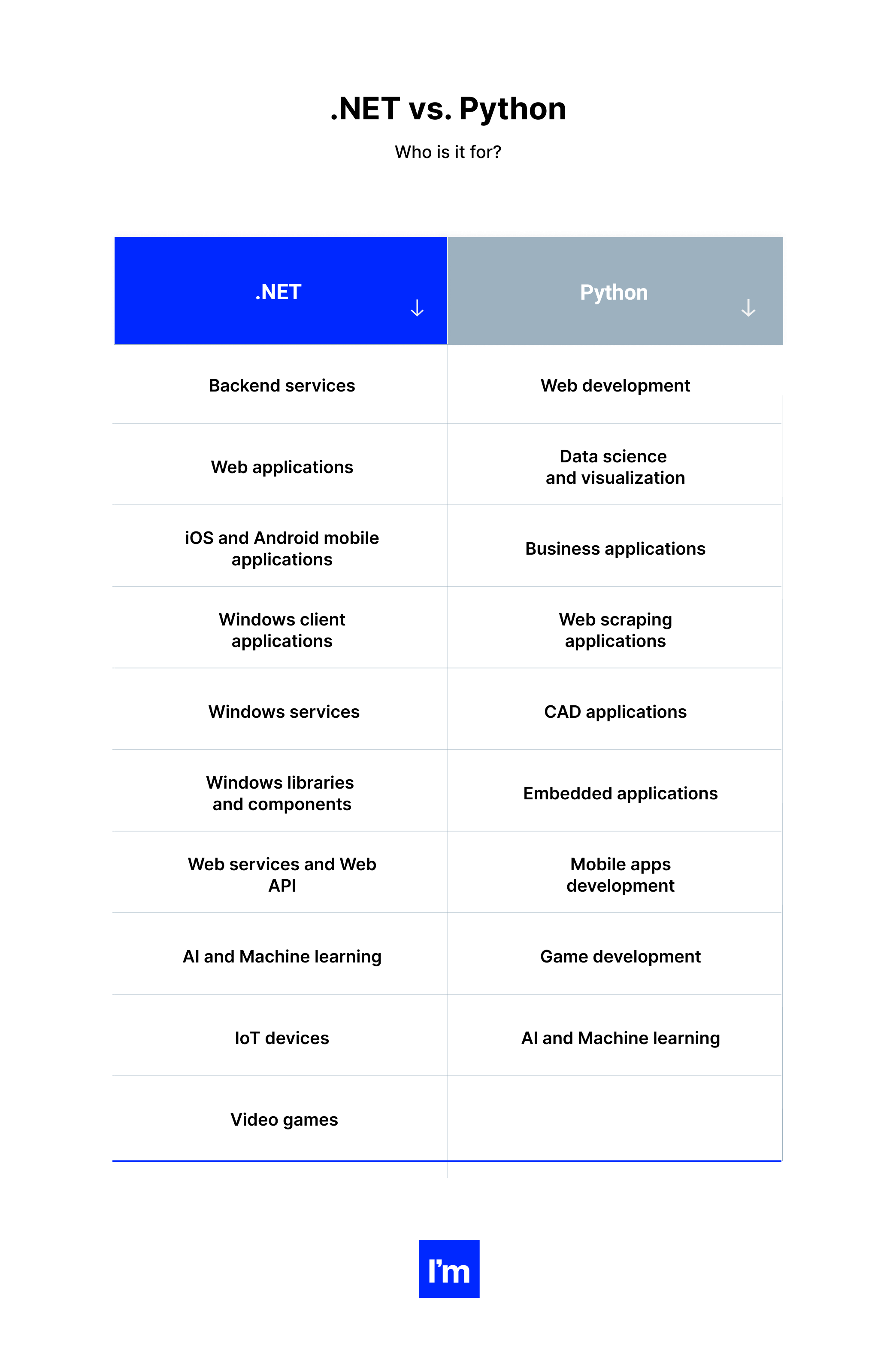
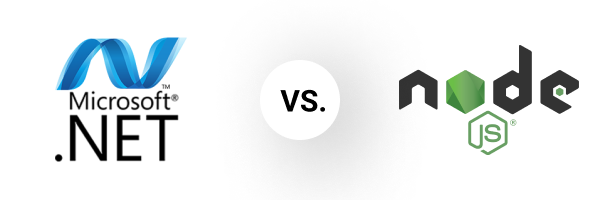
ASP.NET and Node.js are two modern server-side development frameworks. What platform should you use when developing web applications? What's the difference when comparing .NET framework and Node.js? Let’s see together.
Speed of development
In Node.js, all elements are developed and supported by different developers. All of them are created by taking different ideas, standards, and requirements into account. Hence, you may need to refer to the documentation now and then.
In ASP.NET, most of the required plug-ins, modules, and NuGet packages are developed by Microsoft. As a result, the chances to delete modules or change names are very rare.
Performance
A huge number of developers have stated that they have seen better performance after porting their applications to Node.js.
Node.js is capable of multitasking with ease as it runs on the high-performance JavaScript V8 engine. Moreover, it can handle more traffic without any external server requirements.
When comparing ASP.NET to Node.js performance, it varies depending on project requirements. Node.js handles tasks easily where less computation is required. However, as the task gets more CPU intensive, Node.js crashes.
The most recent version of the .NET multi-platform engine is 15% faster than earlier versions and much more powerful than ASP.NET.
Versatility
You can use any popular text editor to develop any web application using Node.js. However, the standard option is to use WebStorm (IDE) as it increases overall performance and has enhanced community support.
There are many tools on the market like LINQPad, NDepend, ELMAH, etc. that you can use to build innovative next-generation websites and web applications. Typically, developers prefer to use tools like Visual Studio, Web Essentials, and Resharper.
Cost of development
One of the biggest problems with ASP.NET is its high cost. This adds to the huge costs of SQL Server licenses, Windows Server licenses, and Visual Studio licenses.
When comparing the average rate of .NET and Node.js developers, the latter makes $113,791 annually.
Ease of finding developers/developer pool
Compared with other more popular languages, the .NET developer pool lacks manpower. However, still, a decent .NET development company can provide you with seasoned devs for any purpose.
Who is it for?
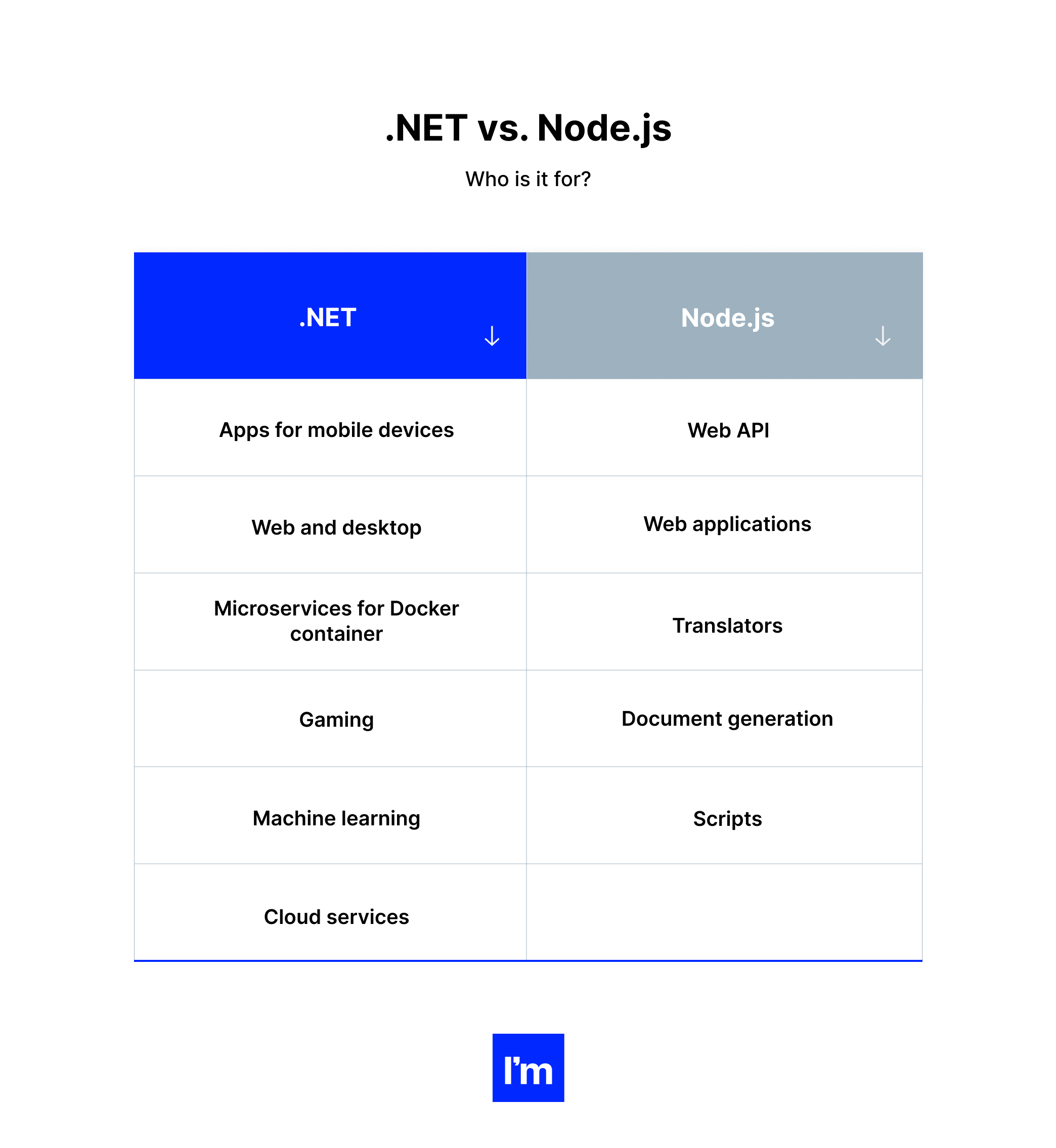
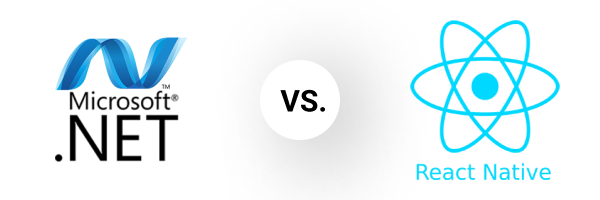
In terms of this comparison, it’s better to see what Xamarin can offer us compared to React Native. Currently, React Native and Xamarin are trending and leading the way. So, which one should you choose to develop a game-changing application?
Speed of development
The hot reload feature in React Native increases development speed. With this feature, developers can instantly reload an application without having to compile it.
In addition, React Native offers many pre-built components that you can use to speed up your app development.
The development tools in Visual Studio speed up the development process with built-in controls and layouts. Alternatively, you can install Xamarin and NuGet plugins to make things easier.
Performance
Since cross-platform and hybrid frameworks are known to sacrifice performance for convenience, this category is paramount to your final decision.
While both Xamarin and React Native offer near-native performance, Xamarin runs the fastest code on Android and iOS and has a user interface (UI) for using native tools.
Versatility
Both Xamarin and React Native have out-of-the-box components to improve productivity and usability, which leads to greater versatility. But despite React Native's live reload feature, the framework as a whole pales in comparison to Xamarin.
Xamarin.Forms, along with Xamarin.iOS, and Xamarin.Android, gives developers the ability to create custom UI components for specific platforms. This way, Xamarin developers can get closer to native performance than React Native developers.
Cost of development
React Native is a very flexible framework allowing developers to choose their preferred IDE. React Native is also a clear winner in terms of accessibility as it's free! With React Native, mobile developers can use the framework and all of its libraries at no cost!
Xamarin also has a free version, although it has a very limited feature set and fewer resources than React Native. In addition, while the platform itself is available for free, using Visual Studio comes at a cost.
Ease of finding developers/developer pool
According to a StackOverflow poll, React Native has become the 6th most popular framework as well as the 8th most popular cross-platform app development framework on the market. In addition, React Native was ranked 3rd in the ranking of the most in-demand frameworks.
Compared to React Native, Xamarin did not perform as well in the polls.
Xamarin was ranked 10th among the most popular platforms for developing cross-platform applications and 11th among the most in-demand platforms. Without a shadow of a doubt, developers chose React Native as the best choice. Hence, finding Xamarin devs will be more challenging .
However, using our free .NET developer job description and ad template, you will forget about the shortage of manpower.
Who is it for?
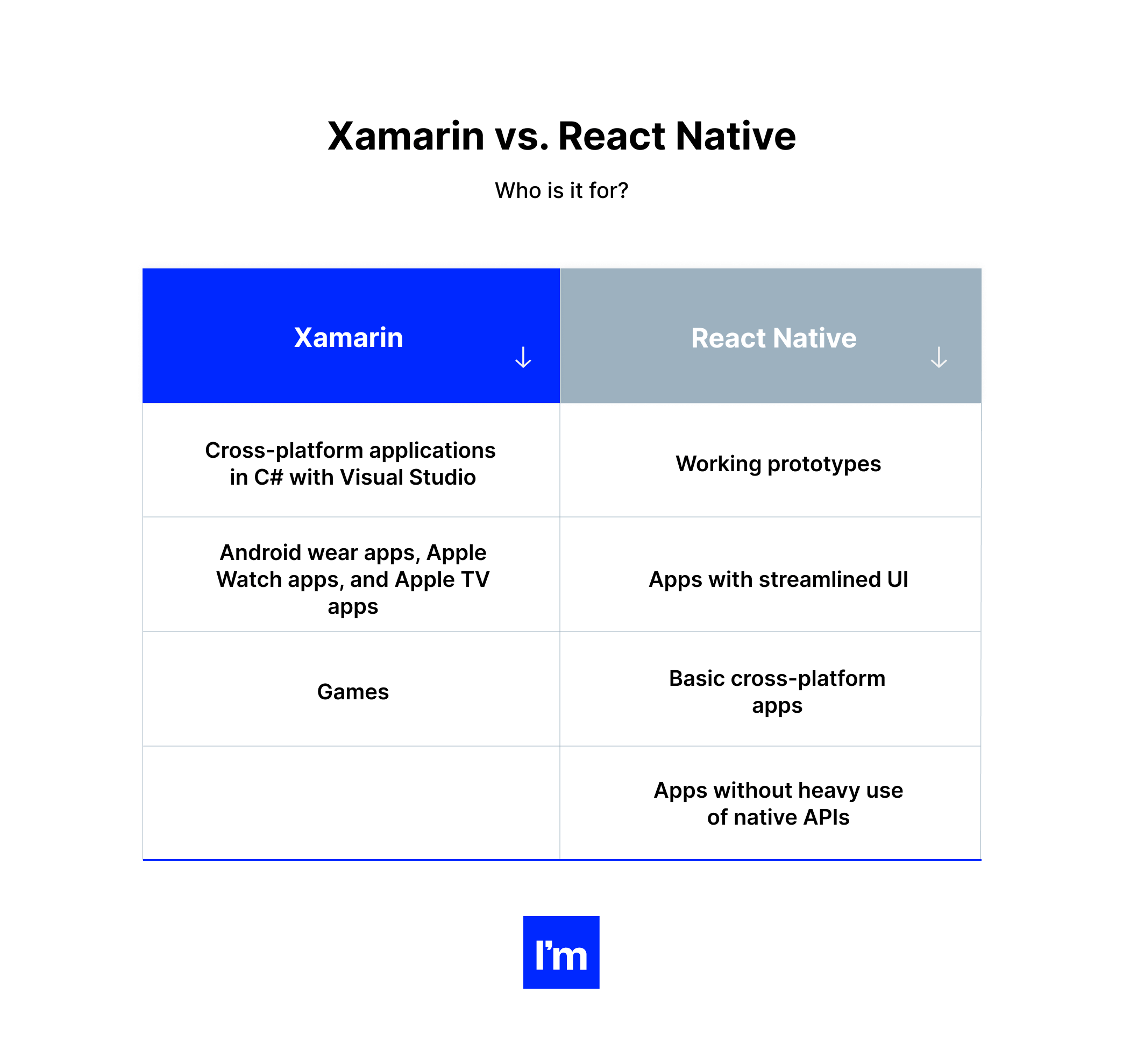
05 Pros and cons of .NET development
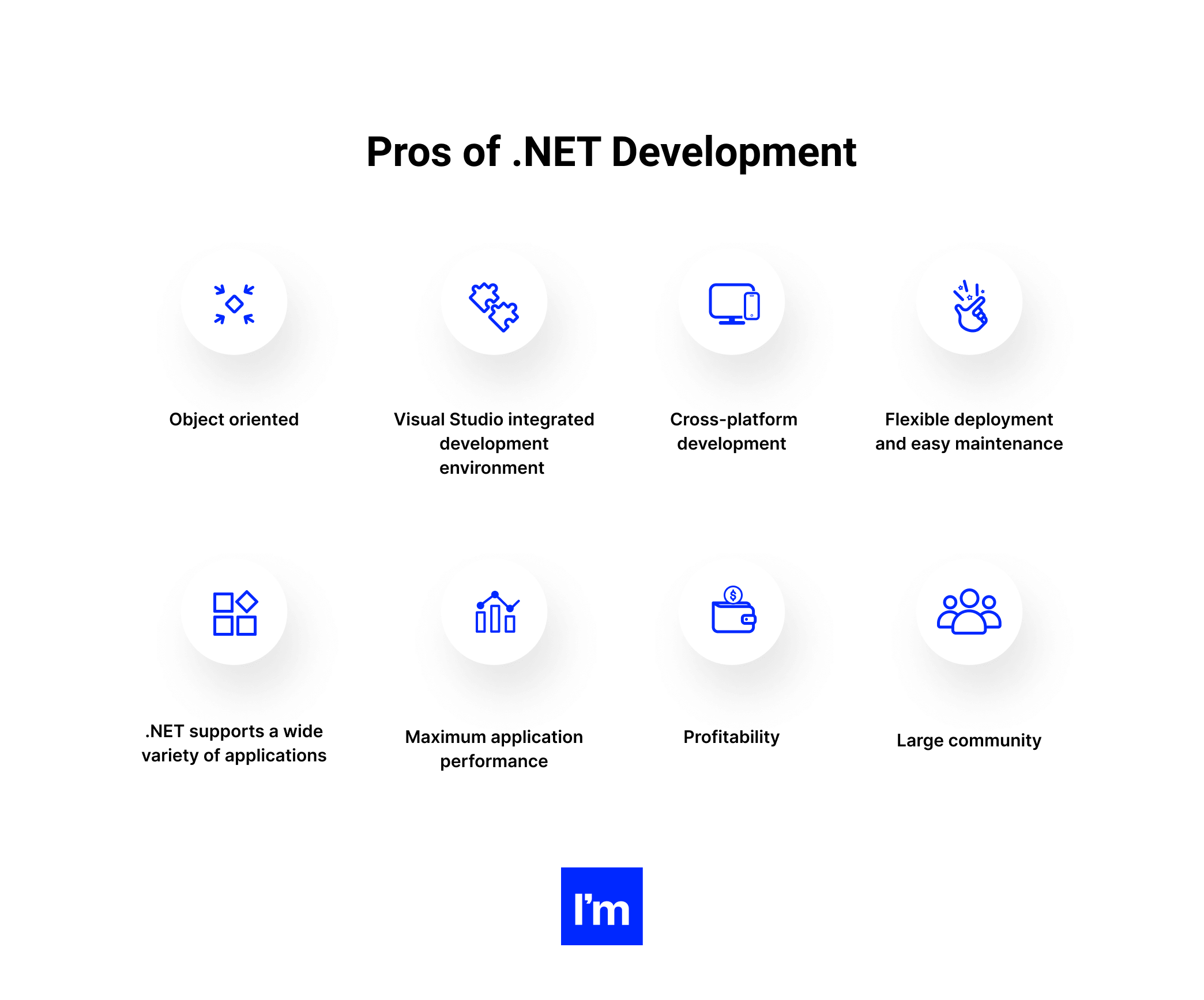
#1. Object-oriented
.NET is based on the Object-Oriented Programming module. OOP is a development model that involves breaking down software into smaller, manageable pieces. OOP divides data into data fields and describes the behavior of objects through class declarations.
An object-oriented programming module simplifies things by making your code manageable, responding to repetitive problems, and simplifying testing. This eliminates the need for programming leading to less code for developers. In addition, .NET allows you to reuse components and code, thereby saving development time and costs.
#2. Visual Studio integrated development environment
The IDE simplifies application development by providing the software you need to write and test.
Visual Studio is an integrated development environment from Microsoft that is used to build, debug, and publish applications on a variety of platforms, including Android and iOS.
Key features of Visual Studio IDE:
- It is a single IDE for all .NET applications.
- The IDE includes debugging and built-in compilation functions.
- It can be used for applications based on code written in different languages.
- The environment can also be customized to the user's preference.
Apart from this, Visual Studio Marketplace also offers a wide range of editor extensions that enable continuous integration, team collaboration, cloud development management, and third-party connections.
#3. Cross-platform development
.NET Core is cross-platform, which means it allows you to run code on Windows, Linux, and OS X. The .NET Core, unlike the original .NET platform, is completely open-source, ensuring that the wider engineering community can contribute to its development.
If you write code in F#, C#, or Visual Basic, your code will run on each of the compatible operating systems. This allows companies to leverage a wide variety of platforms while remaining within the .NET ecosystem. At the same time, thanks to its cross-platform nature, the .NET community can also share its large set of engineering skills.
#4. Flexible deployment and easy maintenance
One of the most important and most useful features of .NET is flexible deployment. It can be installed as part of an application you are developing, or separately. The modular design allows all required dependencies to be included. What's more, deploying with .NET is as easy as copying a folder.
Another advantage is that multiple versions of .NET can run on the same computer at the same time, making it easier to work on different projects and deploy smoothly.
#5. .NET supports a wide variety of applications
With the .NET framework, you get the ability to develop many types of applications, such as games, mobile devices, the Internet of Things, and artificial intelligence.
Microsoft recently announced a partnership with SWIFT, which means AI and data will become the center of financial technology. This will include building an ecosystem that offers efficient and secure transactions for banks and corporations.
Companies have realized the enormous potential of machine learning, big data, and artificial intelligence. They are investing more and more funds to integrate such components into their applications. Healthcare, education, marketing, banking, business, and just about everything in our daily lives can use artificial intelligence and big data to make life easier.
#6. Maximum application performance
Microsoft has improved performance with each version released.
Built with .NET, Stack Overflow, the leading knowledge website for programmers, serves 5.3 million page views per day with just nine servers.
Raygun from New Zealand has developed a cloud-based monitoring application for web and mobile applications. The core of the application was written in the .NET framework, but they used an API that receives data written in Node.js or Linux to maintain elasticity.
Over time, the Node.js framework gets heavier and slower and needs to be scaled up. However, this required investment. Therefore, the company decided to port its API to the .NET. This resulted in a 2,000% increase in their throughput using servers the same size as before.
Combined with the right database and architecture, this framework is the perfect solution for any business that needs to scale.
#7. Profitability
When choosing the right technology, the first thing you check is the IDE and the tools that are required or improve performance. Many of them are free, but the very best come with developer licensing costs that can run into thousands of dollars. It doesn't matter if you are a startup trying to enter the market or a large company, money could be spent more efficiently.
Microsoft's Visual Studio Code is preferred by a large number of front-end web developers because it is good, small, extensible, and updatable.
When it comes to infrastructure, .NET offers you the freedom to choose a provider of your choice, which can provide you with a cheaper service level agreement. Moreover, you can host your application in the cloud.
Even if you are not worried about costs, not having to invest in something that is not critical gives your business flexibility and the ability to invest in developing your team.
#8. Large community
When a framework is used by many companies and developers, it means that it has features that appeal to them. It also demonstrates stability and a high level of trust from the community, which gets everyone to try the framework.
Moreover, a large community means that almost any problem can be solved with the help of community members.
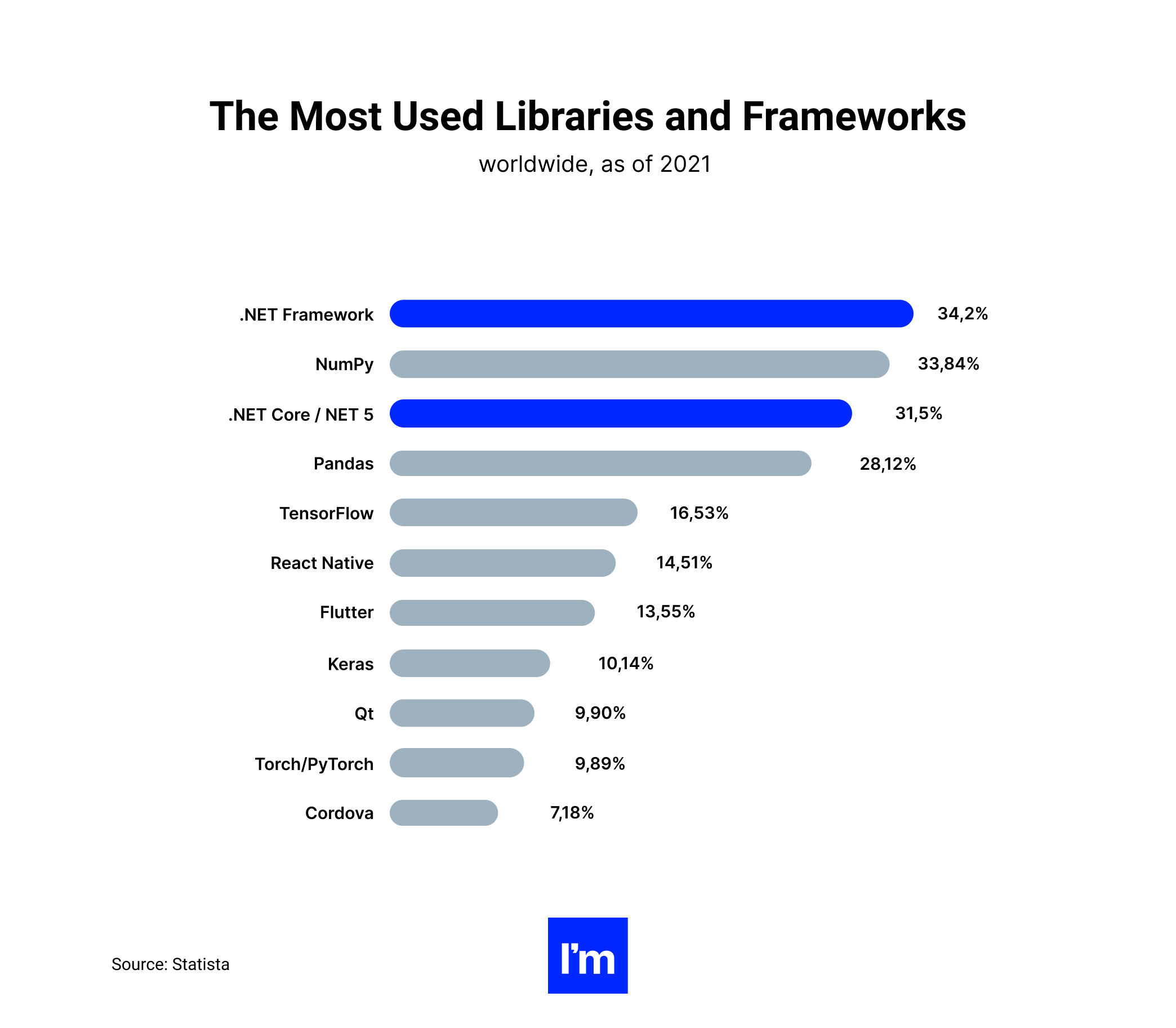
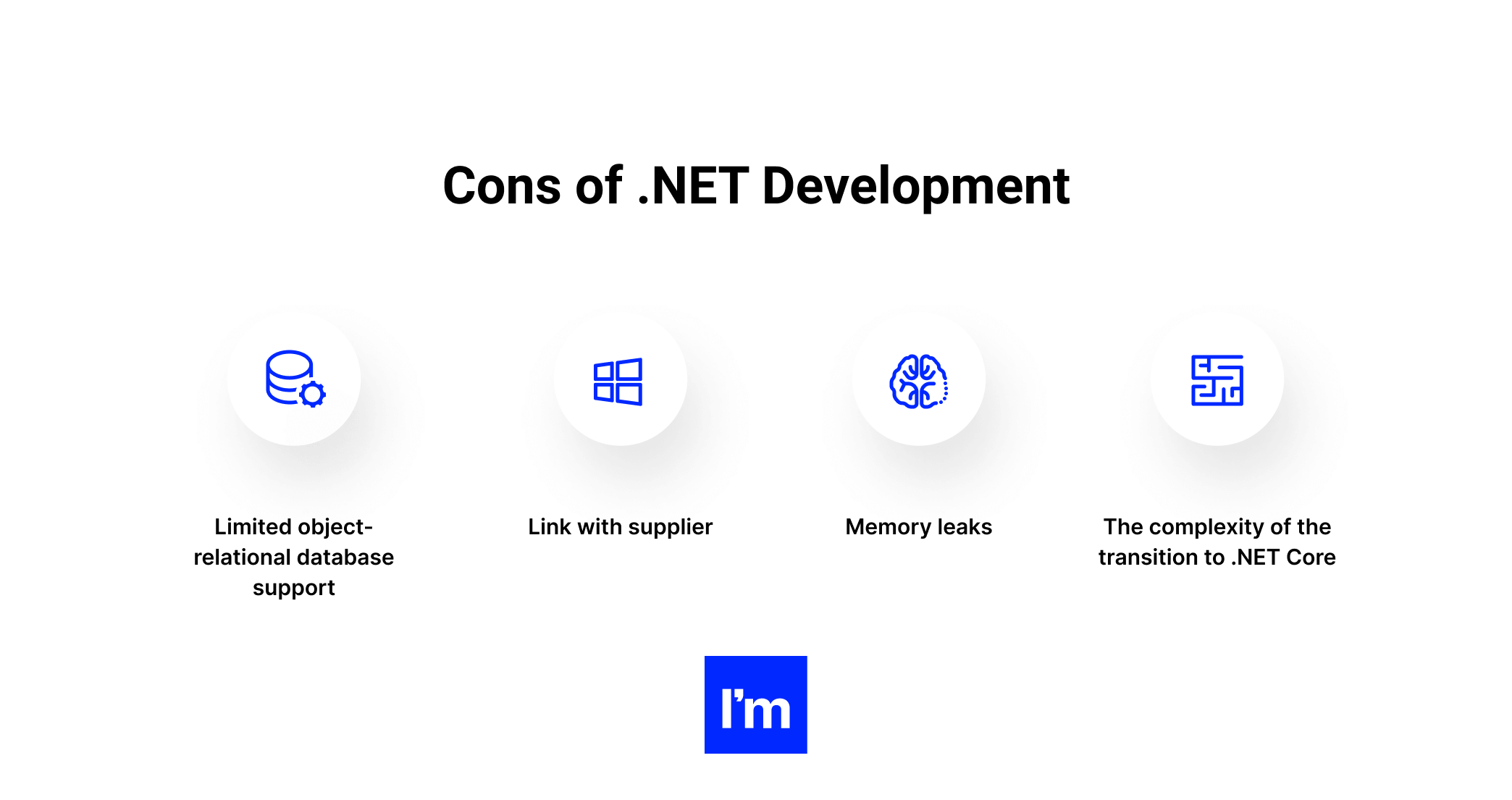
#1. Limited object-relational database support
As mentioned above, .NET works with an object-oriented programming approach that is based on objects rather than actions and data rather than logic. Support for data-centric application development in the .NET Framework is provided by the Entity Framework.
The entity acts as a bridge between the .NET Framework object-oriented databases and SQL. However, some developers feel that the Entity Framework does not offer the required flexibility and does not support all available database designs.
#2. Link with supplier
.NET is a framework from Microsoft. Although Xamarin and .NET Core are open source, the entire ecosystem is far from being community-driven. This means your products will be influenced by decisions made by Microsoft.
#3. Memory leaks
Memory leaks are common in all technologies. .NET is also frequently criticized for memory problems and memory leaks. Although .NET has a garbage collector to address this issue, engineers still need to invest additional effort in resource management.
#4. The complexity of the transition to .NET Core
The transition to .NET core can be long and difficult. Applications built using older versions of .NET are much larger than applications built using .NET Core. Migrating these applications to the latest versions of .NET can be a little difficult.
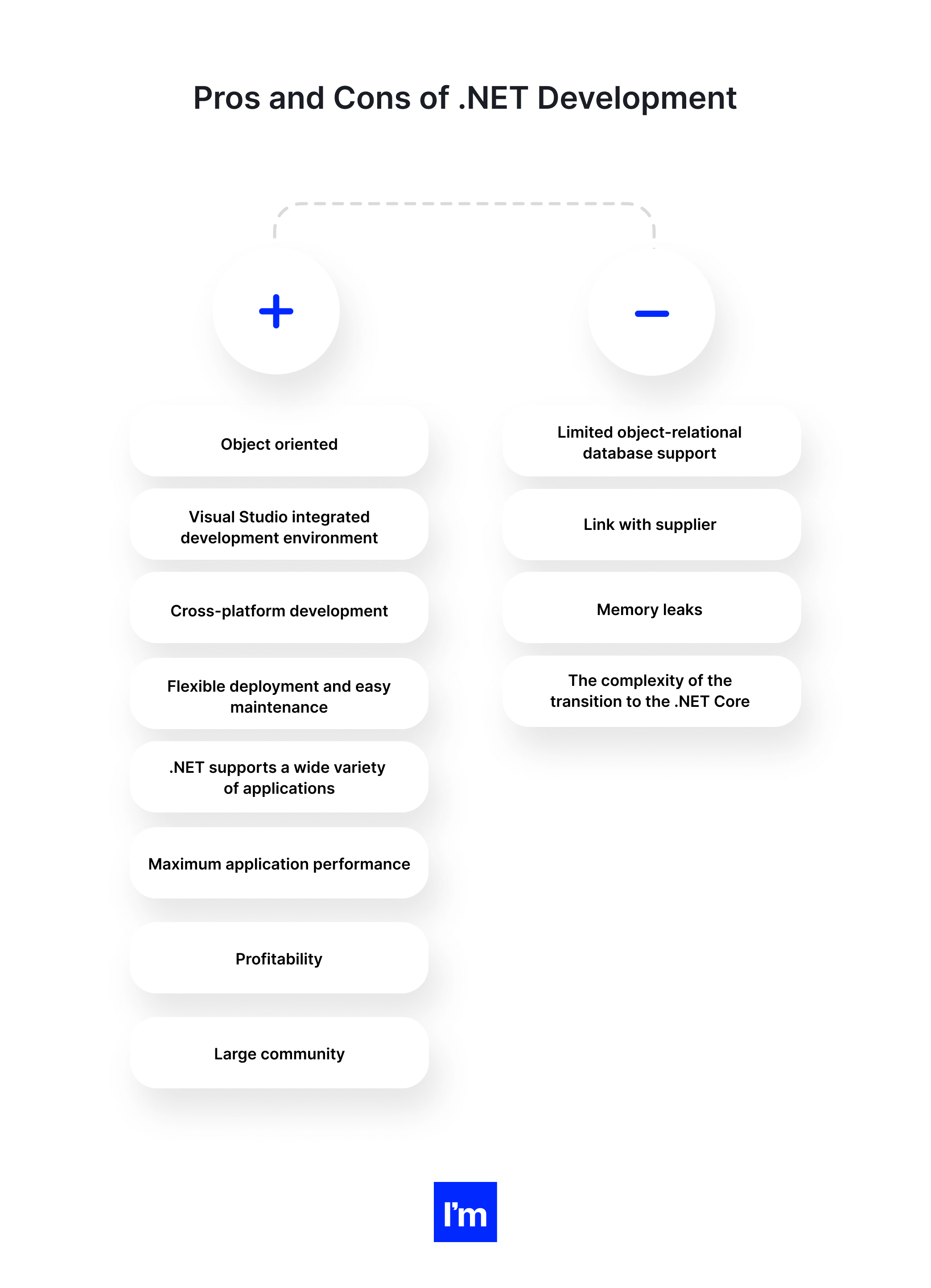
06 Hiring .NET developers and teams - what should you know?
.NET developers’ global share
IT talent can make or break a company's success. Experience, skills, and knowledge become a priority for recruiters. With the rapid growth of the IT industry, finding and hiring talent is becoming a real challenge. Finding and hiring .NET professionals can seem even more daunting.
.NET Framework, .NET Core, and .NET 5 are the most used libraries and frameworks in 2021.

In terms of the number of .NET developers worldwide, there were about 6 million .NET developers according to an old study from 2004. Today, using many assumptions, there are about 7-8 million .NET developers. Most of them use C#.
Who do you need?
Different tasks require different levels of knowledge. The same goes for the .NET programmer competencies you might need for a project. Here's a list of the possible scenarios:
- You are looking for a single dev for the team;
- You want to scale an existing team;
- You need to put together a .NET development team from scratch.
Every scenario needs a different approach. But first, let’s figure out what skill set .NET developers of different grades ought to have:
|
Level of programmer |
Experience |
Skills |
|
Trainee |
less than 3 months |
C#, understanding of OOP principles |
|
Junior Beginner |
3 months |
C#, ASP.NET, understanding of OOP principles, HTML, CSS |
|
Junior Upper |
9 months |
All of the above + JavaScript, LINQ, SQL |
|
Junior Advanced |
1.5 years |
Experience with all of the above + Angular/ReactJS, Entity Framework |
|
Middle Beginner |
2 years |
All of the above + comfortable working with SQL server and front-end technologies |
|
Middle Upper |
2.5 years |
All of the above + Bootstrap experience, database query optimization, miniORMs |
|
Middle Advanced |
3 years |
All of the above + REST APIs best practices, GraphQL, strong debugging |
|
Senior |
5 years |
Proficiency in web app development, deep knowledge of C#/ Visual Basic programming language, strong debugging skills, Docker, familiarity with Agile environment, cloud development, application architecture patterns |
|
Tech Lead |
5 years |
The capacity to develop & mentor, ASP.NET, C# solutions, knowledge of MSSQL, experience developing highload systems, experience with Agile/Scrum methodologies, automated unit testing, strong organizational/ management skills |
|
Architect |
6 years |
Architecting complex web applications using .NET framework, expertise in the following: ASP.NET, ASP.NET MVC, creating .NET Core applications, experience creating data access components with LINQ and Entity Framework, building web APIs |
|
Senior Architect |
8 years |
3+ years experience of senior programming, proficiency with .NET technology stack, expertise in building large enterprise solutions, using front-end frameworks, experience with debugging, Jira, metric collection tools, tech writing skills |
|
CTO |
8 years |
Deep understanding of tech trends, skills in creating budgets and plans, leadership abilities, profound knowledge of .NET programming |
Where to find .NET developers
Finding a candidate who meets your expectations takes time. To simplify the process, first decide if you need an in-house specialist, a third-party specialist, or a freelance specialist. This will help you narrow down your pool of candidates.
You can use various sources to select candidates. Here are the best ones to find .NET developers:
Community and freelance platforms
There are many digital platforms that could be a potential source for your next .NET developer hire. Most of these platforms are places where programmers go and showcase their skills, and you can use them to work in your firm. There are a lot of them, but we’ll mention a couple of such popular platforms.
- Stack Overflow is a Q&A site for everything IT and programming, with a vibrant and active developer community. The platform allows programmers to post their resumes and highlight their skills, while recruiters can also post vacancies or reach out to potential candidates through the website's job market database.
- GitHub is another popular coding platform with 28 million users sharing their coding skills. For a minimal fee, you can post job advertisements on the platform and discover all types of .NET developers, from beginners to mid to senior .NET professionals.
Apart from online programming community platforms, there are many freelance websites like Freelancer and Upwork where many good freelance programmers can be found with competitive pay rates. This is only recommended if you want to hire a developer for a short-term project or specific task.
Job Sites
The second way to hire .NET developers is through job websites and job boards. Examples of such sites include Indeed, Monster, Glassdoor, and SimplyHired. These websites will allow you to filter candidates based on your specific requirements from hundreds and thousands of potential employees who register on the platform. This option is also suitable for projects where you have to hire no more than three workers.
Tech talent marketplaces
While the previous two paths may not work for your case, one of the best and most reliable ways to find and hire a good developer/team of devs is to seek the help of a tech talent marketplace. Such a service will not only save you a lot of time and effort, but it will also give you a 100% chance that you will hire the right developer.
No matter what hiring option you are looking for (just a freelancer or a fully dedicated team of seasoned pros), choosing to deal with a tech talent marketplace is the best way to go through the hiring process.
How much does it cost?
The average .NET developer salary in the US is $93,500. Keep this number in mind as you read the rest of this section.
In most countries, the average .NET developer salary is lower than in the United States. Some countries are close, but given the US's position as a global technology leader, it makes sense that they would have the highest salaries for .NET developers, with less influential countries lagging behind.
Take their friendly northern neighbor, for example. The median .NET developer salary in Canada is $87,500. You will pay a little more if your business is located in one of the major Canadian cities. For example, the median salary for a .NET developer in Ontario is $110,000.
The average .NET developer salary in the United Kingdom is $72,000. This number is comparatively low.
At the same time, looking at the CEE countries, the cost is even lower. For instance, in Poland, you would pay your .NET coder as little as $21,000 per year.
Simultaneously, the level of expertise of Polish devs isn’t lagging behind USA-based programmers. This was confirmed by numerous polls and case studies.
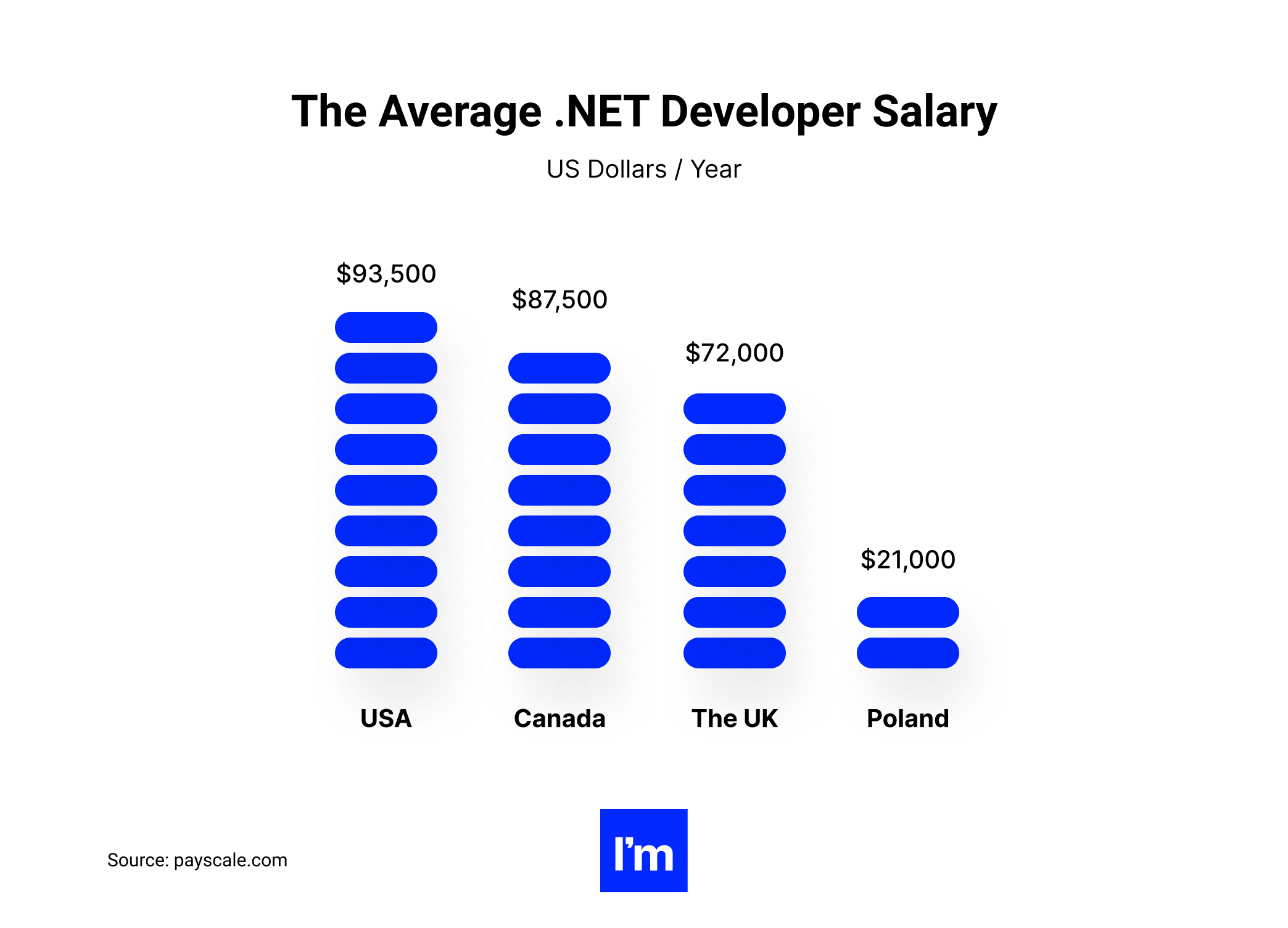
07 .NET development case studies and best use cases. What is out there?
As a key decision-maker working with your development team, you want to make sure the use cases match the tools and software that your team works with. Typically, when developing a new application or new technology to improve your business, there is almost never a one-size-fits-all solution.
There are definitely some factors to consider when using different versions of Microsoft .NET, plus there is a version history that can turn the heads of any team, but it is important to understand your use case and when to use a particular component in .NET. ecosystem.
According to the Stack Overflow survey, usage is only growing and businesses need to understand how they can and should use .NET in their software projects.
This chapter will go over some of the common use cases for ASP.NET in famous projects.
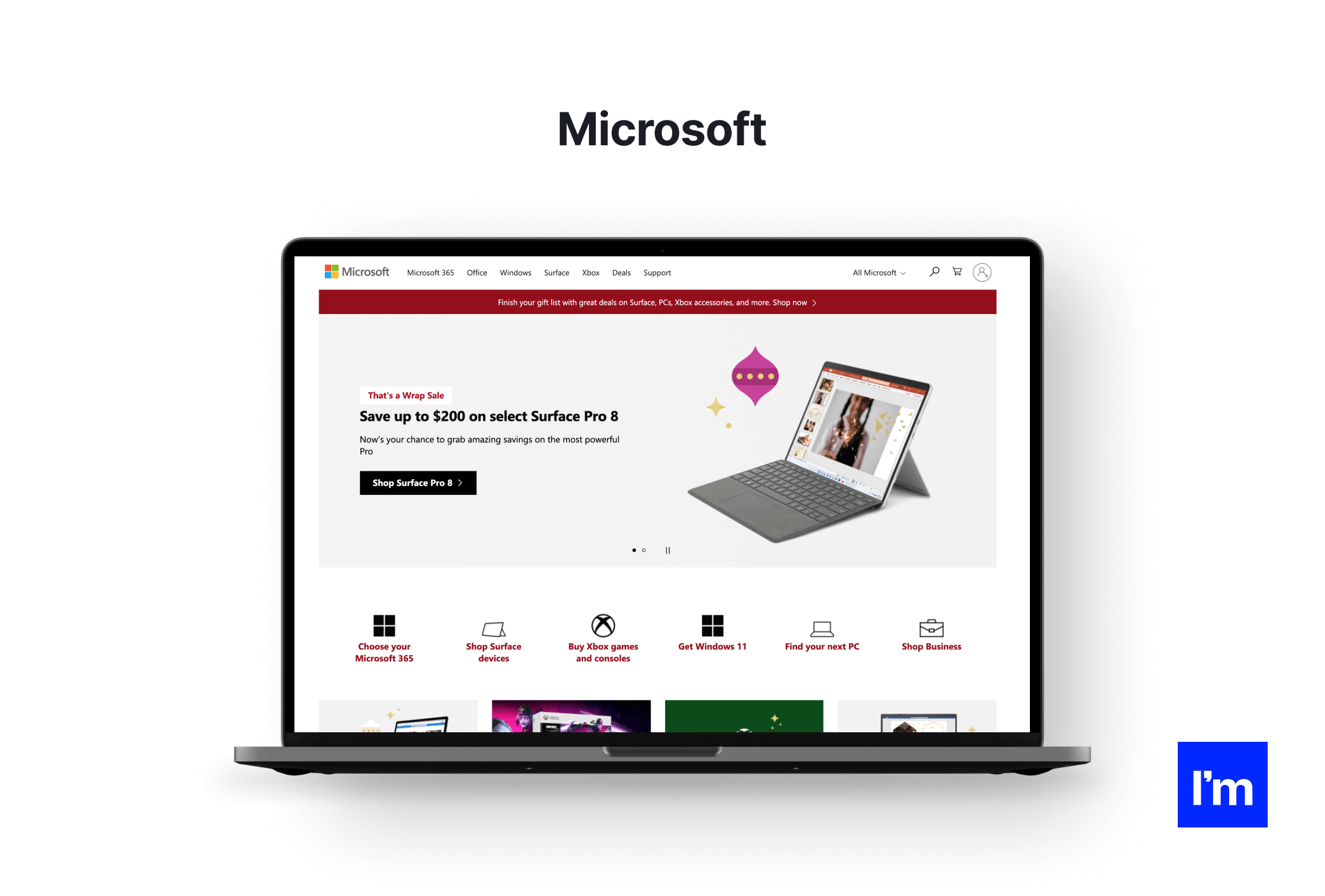
Microsoft created ASP.NET to help programmers build dynamic websites and web applications. And it's no surprise that they use their own product to build their website. The tools they have created for developers are used by their own workers.
Everything is clear and consistent here— the site is responsive, smooth, and simple.
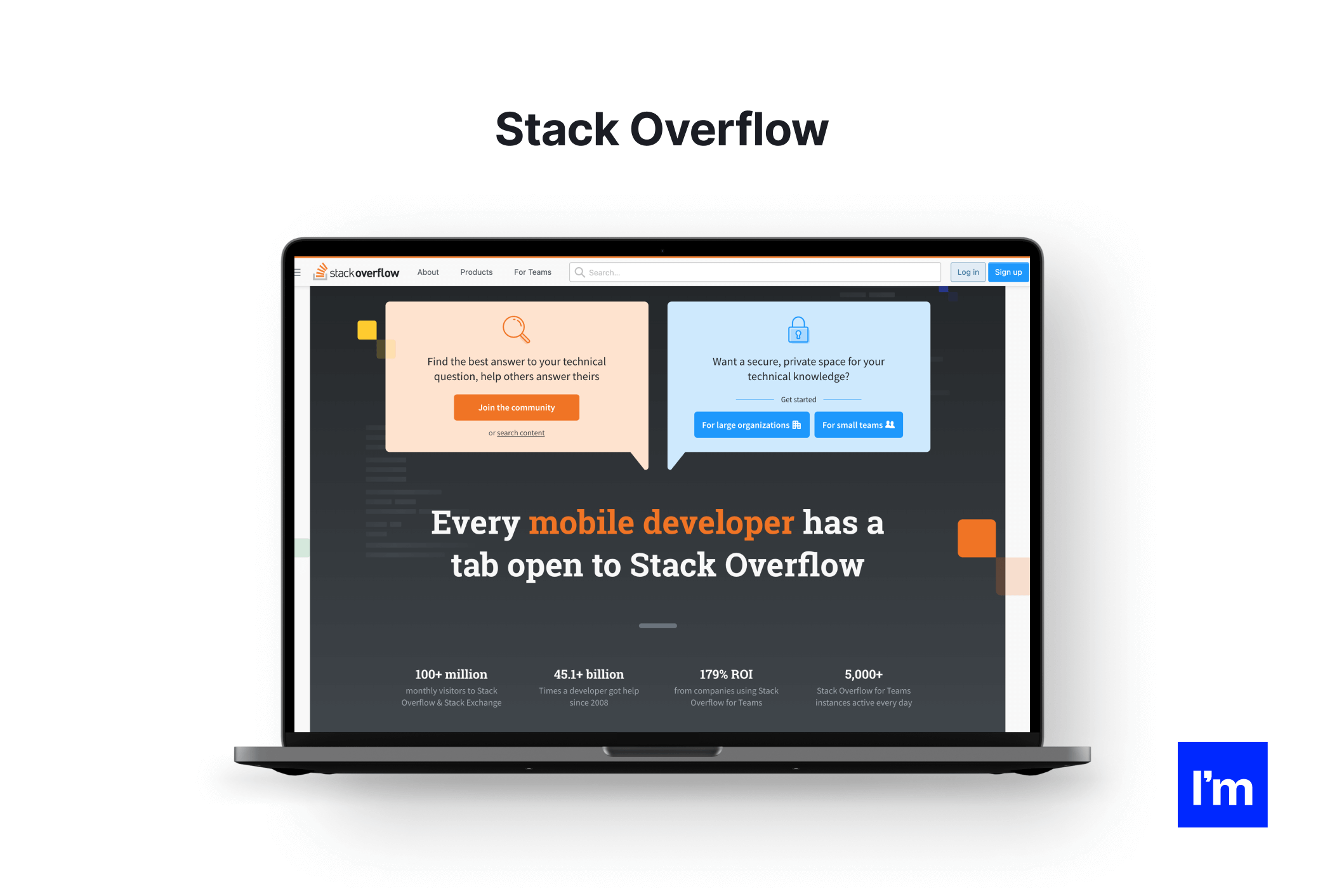
A privately-held website created by Jeff Atwood and Joel Spolsky in 2008, Stack Overflow has evolved into a Q&A site for professional developers and programmers. These programmers contribute to creating a library of detailed answers to all the .NET developer questions that may arise during programming.
The site helps programmers learn their business. Microsoft ASP.NET is a platform in the technology stack used to build Stack Overflow.
According to the architects of this website, it is one of the most reliable pieces of infrastructure they have used, and it allows them to scale the website as needed. With over 16 million page views per month, scalability has been an important factor for a website.

As the name suggests, MarketWatch is a website that presents financial information in the form of business news, analysis, and stock market data. In addition to tracking the pulse of the market, it serves over 16 million visitors and several million new visitors every month. In addition to stock market quotes, the site also offers personal finance tips.
It makes good use of the core features of ASP.NET — extensibility, and scalability — to make a website highly structured and efficient, managing huge amounts of content without disruption.
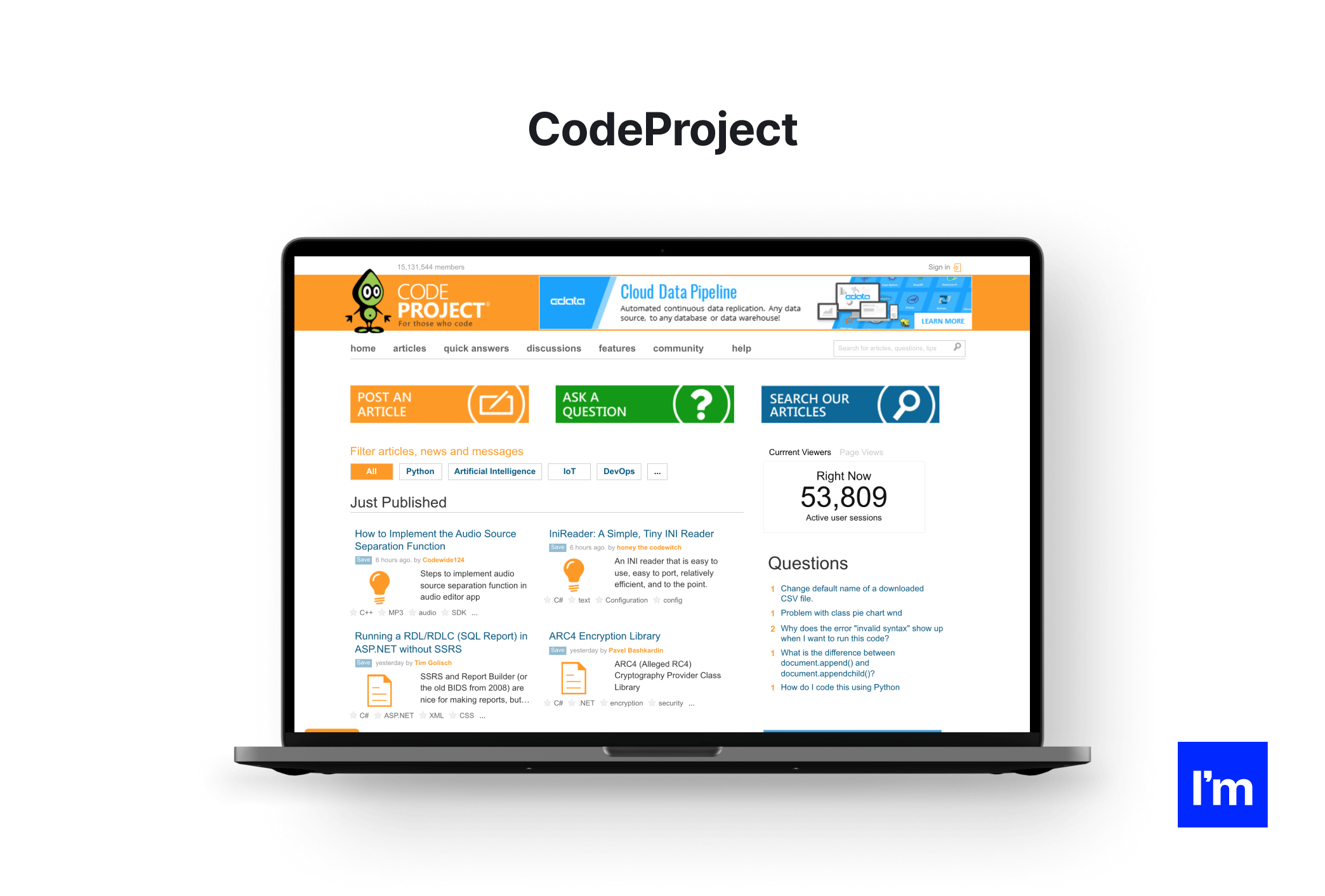
CodeProject provides free source code and guides for software developers and architects. It is a huge platform on which ideas are generated and disseminated, and programmers use them to solve their problems and to keep abreast of the latest technologies.
ASP.NET helped website developers manage and scale CodeProject as needed. CodeProject, with its flexible platform and huge community, is truly one of the best for creating new projects.
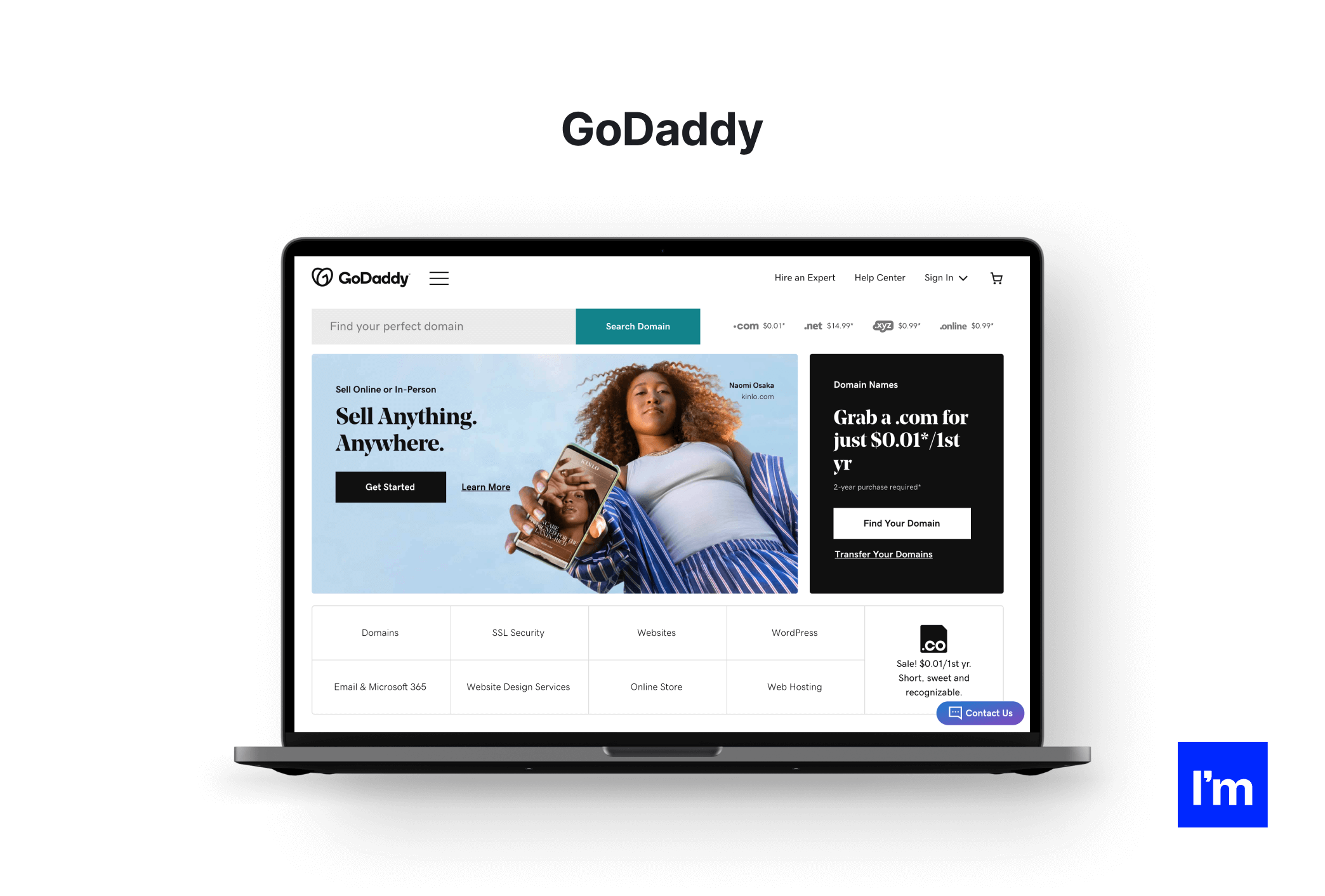
GoDaddy is a familiar name among people who host websites. It is a public internet domain registration and web hosting company that serves over 17 million customers. The company's website is also built on ASP.NET.
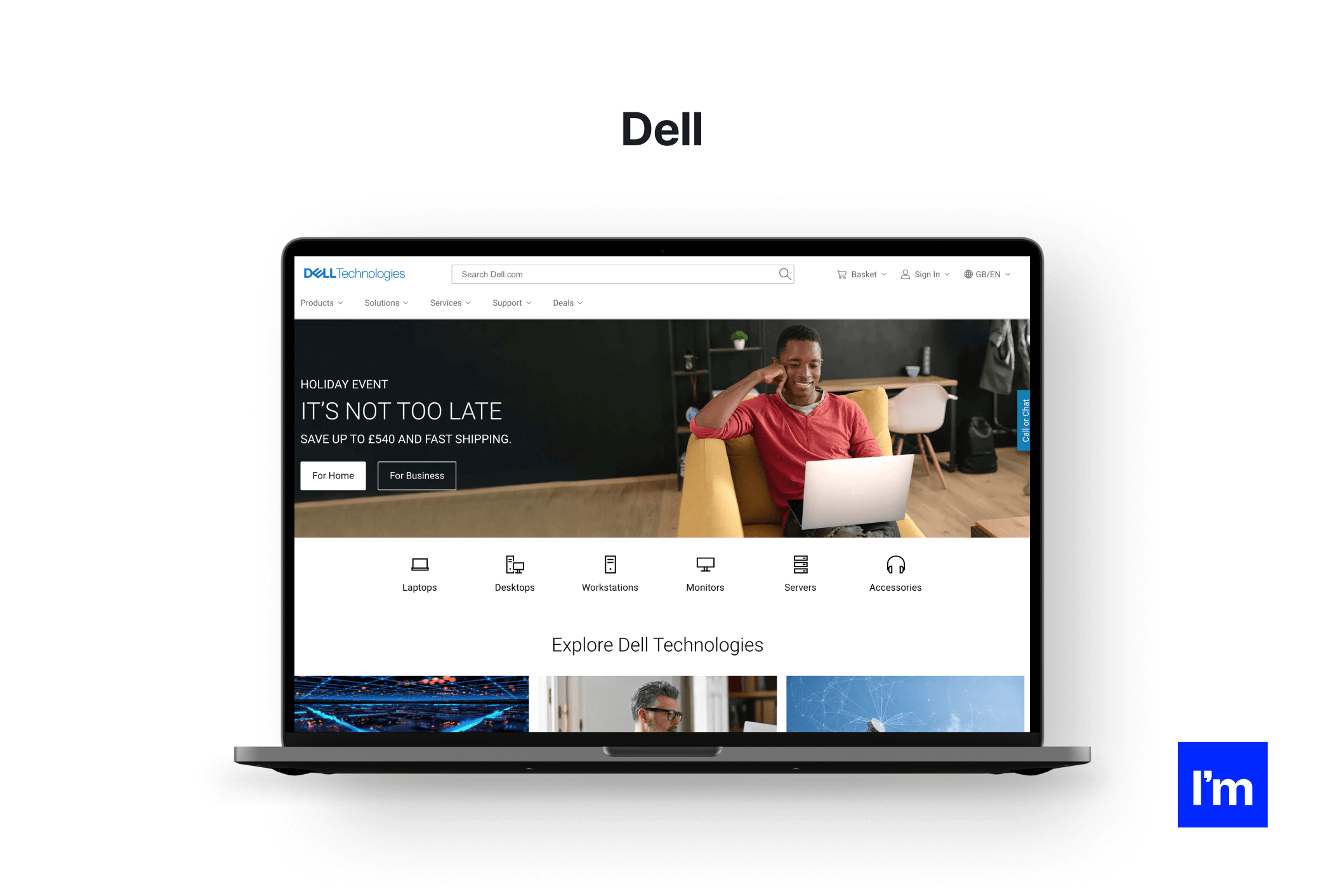
A well-known portal of a well-known PC provider. But we have to admit that Dell has become more than just a PC manufacturer these days. Indeed, if we take a close look at its website, we can see that the company boasts dozens of software solutions, including cloud computing. A site written with the .NET framework has many features. Don't believe us? Come and check it out!

One of the leading accounting software solutions for managing your business on the go. The company's software products are designed for small and medium-sized businesses. The product is powerful, stable, and reliable.
Since .NET is known for its security and reliability, accounting/payroll applications are also key use cases. .NET offers services to prevent unauthorized modification or manipulation of the code. Developers can securely provide modules for accounts receivable and payable, accounting, inventory management, and more for small and large businesses. .NET also has robust features that any accounting system application should have, including automatic monitoring.
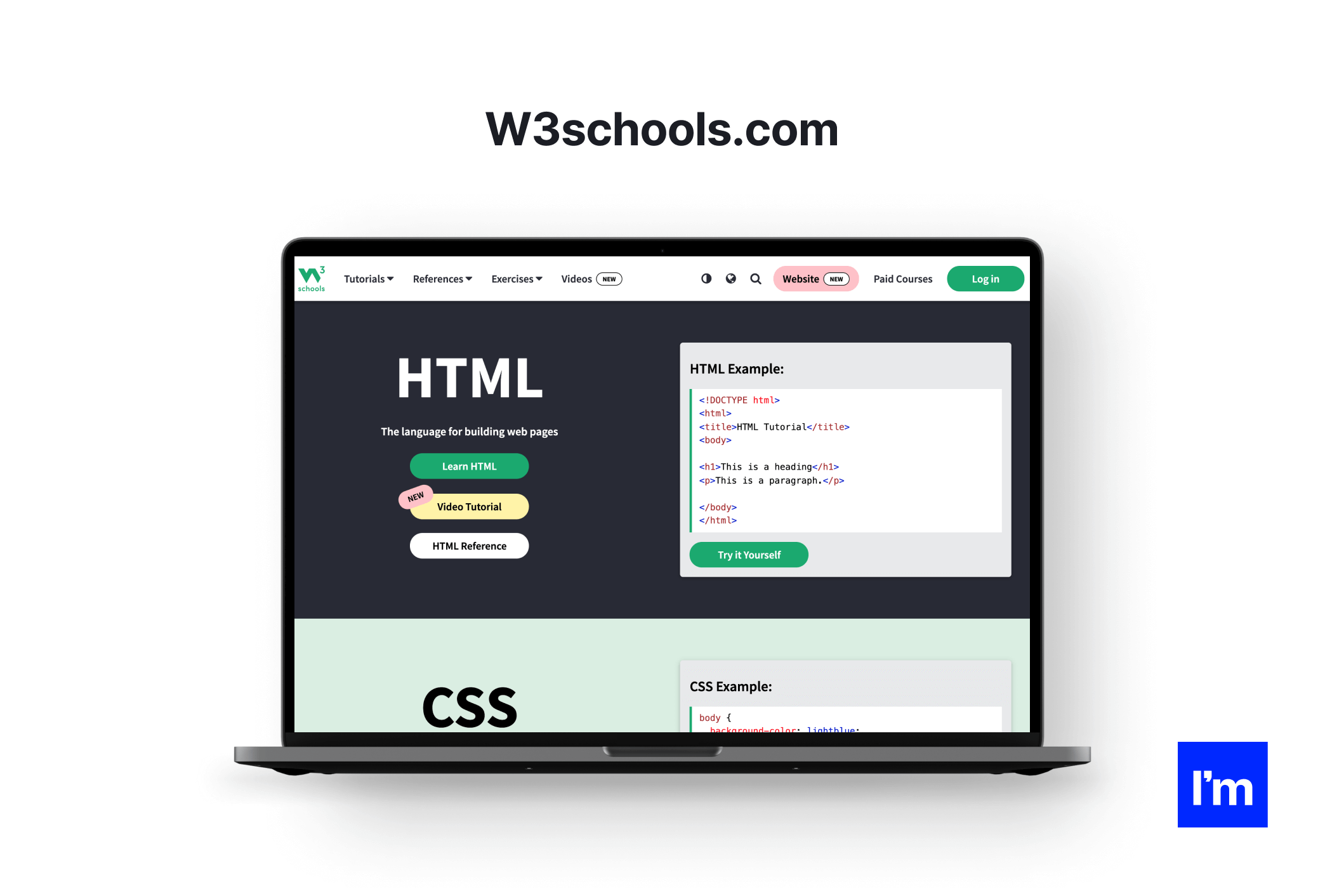 A popular open-source programming platform hosting thousands of code examples. HTML, CSS and JavaScript, SQL Server, and other common programming problems, W3schools.com covers them all. Use it to learn, test, and implement interesting things in the simplest and most efficient way. Avoid mistakes and use sensible code. In fact, many IT professionals consider it to be one of the best web services for gaining IT knowledge.
A popular open-source programming platform hosting thousands of code examples. HTML, CSS and JavaScript, SQL Server, and other common programming problems, W3schools.com covers them all. Use it to learn, test, and implement interesting things in the simplest and most efficient way. Avoid mistakes and use sensible code. In fact, many IT professionals consider it to be one of the best web services for gaining IT knowledge.
08 .NET today and tomorrow
The state of .NET as for the beginning of 2022
The large annual Stack Overflow Developer Survey reveals some curious data, for example, .NET Core/.NET 5 is the “favorite” development environment outside of the internet, although the old .NET Framework it replaces is still in use.
The SO survey is one of the largest in the software development ecosystem, with over 80,000 developers polled in the 2021 version to provide their views on tools and trends.
The survey questions measure "love" and "fear" for various products, as well as which products are "in demand."
For example, .NET Core (now just .NET 5, .NET 6, etc.) was reported to be the “favorite” outside of web frameworks/libraries, reported by 72.67 percent of respondents, although 27.33% said it was "dreaded".
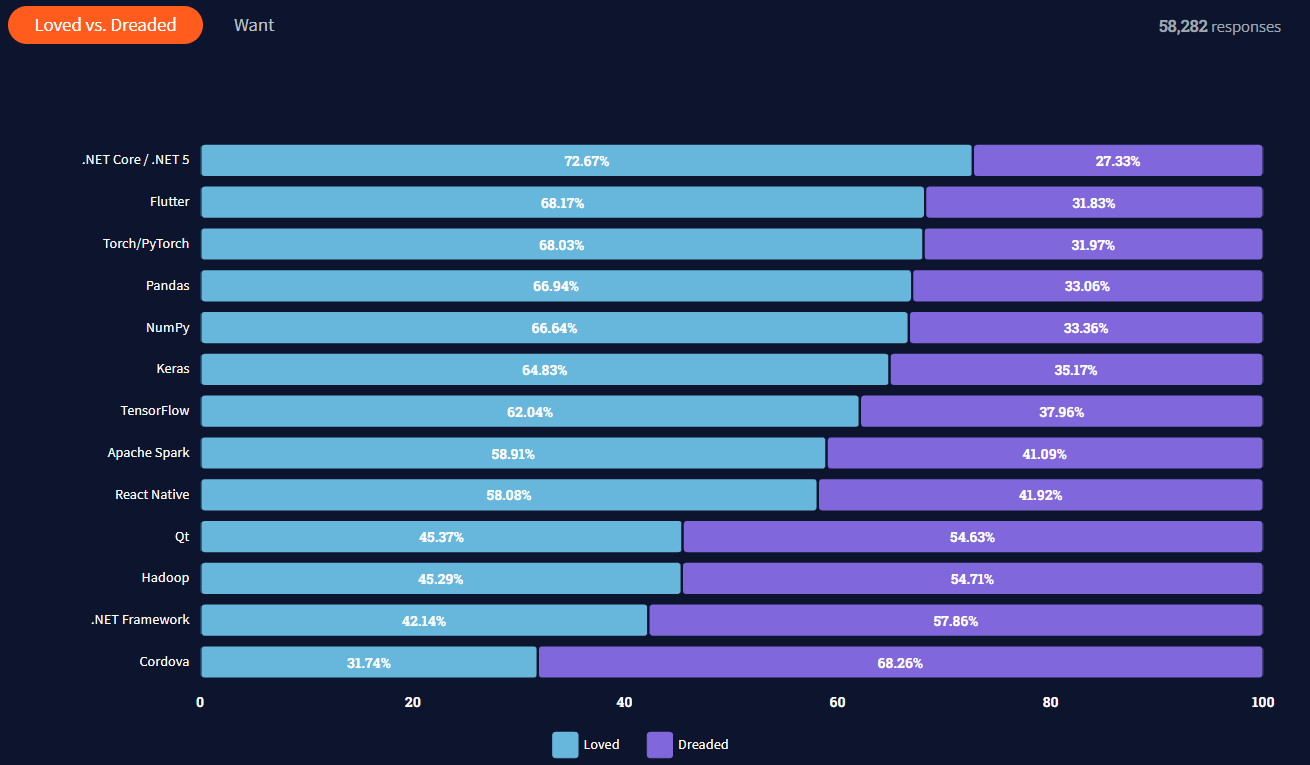
.NET Core was also the most beloved framework outside the web in the 2019 and the 2020 surveys.
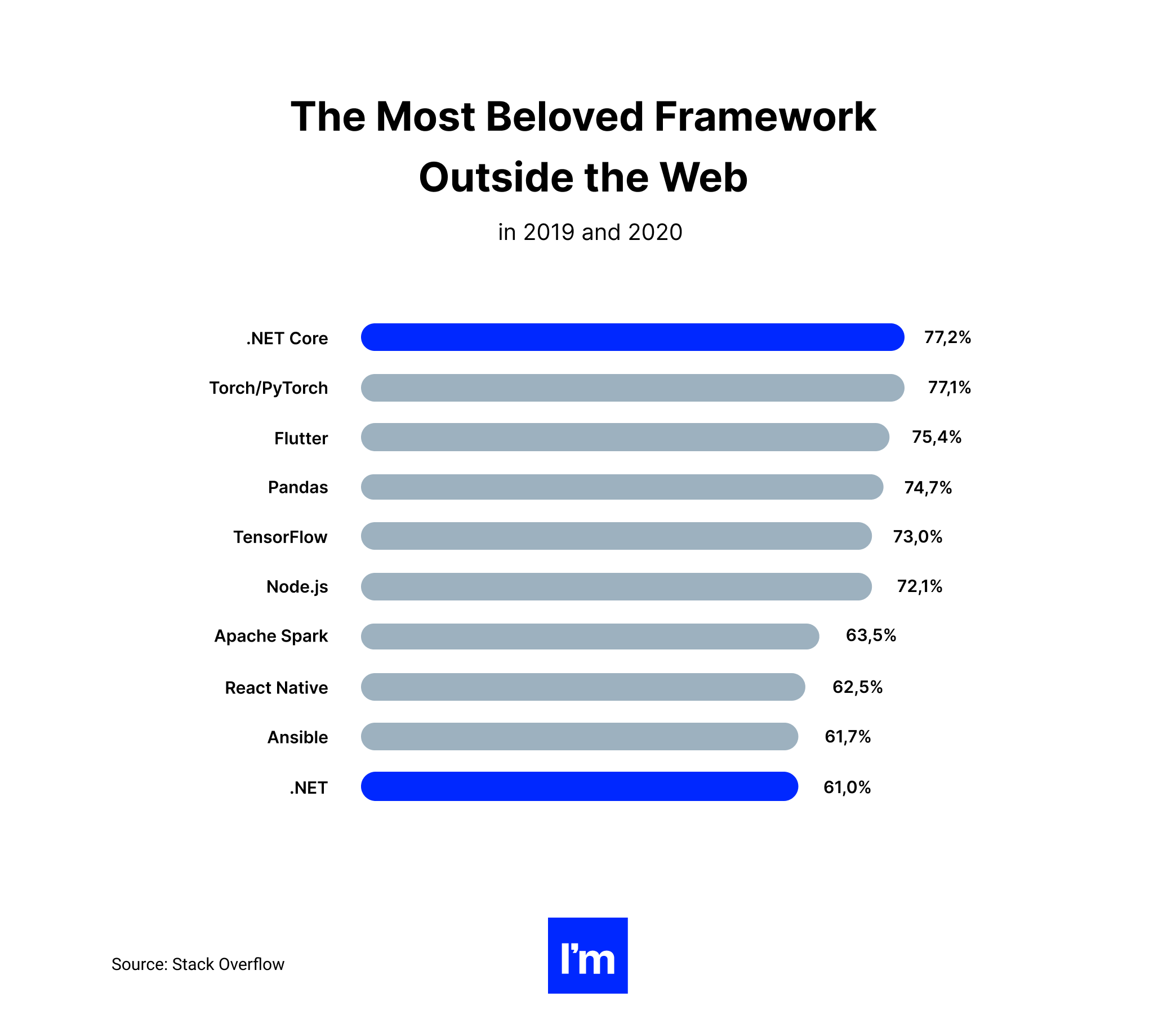

.NET Core/.NET 5 is, of course, an open source, cross-platform Microsoft product that evolved from the outdated proprietary .NET Framework for Windows. Although the new approach has been adopted by millions of developers, SO research shows that the .NET Framework tops the list of “other frameworks and libraries.”
In fact, the 19-year-old .NET Framework was used by 34.2% of all respondents, while the much newer .NET Core / .NET 5 was cited by 31.5%, trailing NumPy at 33.84%.

Among professional developers, .NET Core/.NET 5 performs best (35.26% of respondents), ahead of NumPy and behind .NET Framework with 37.1%.
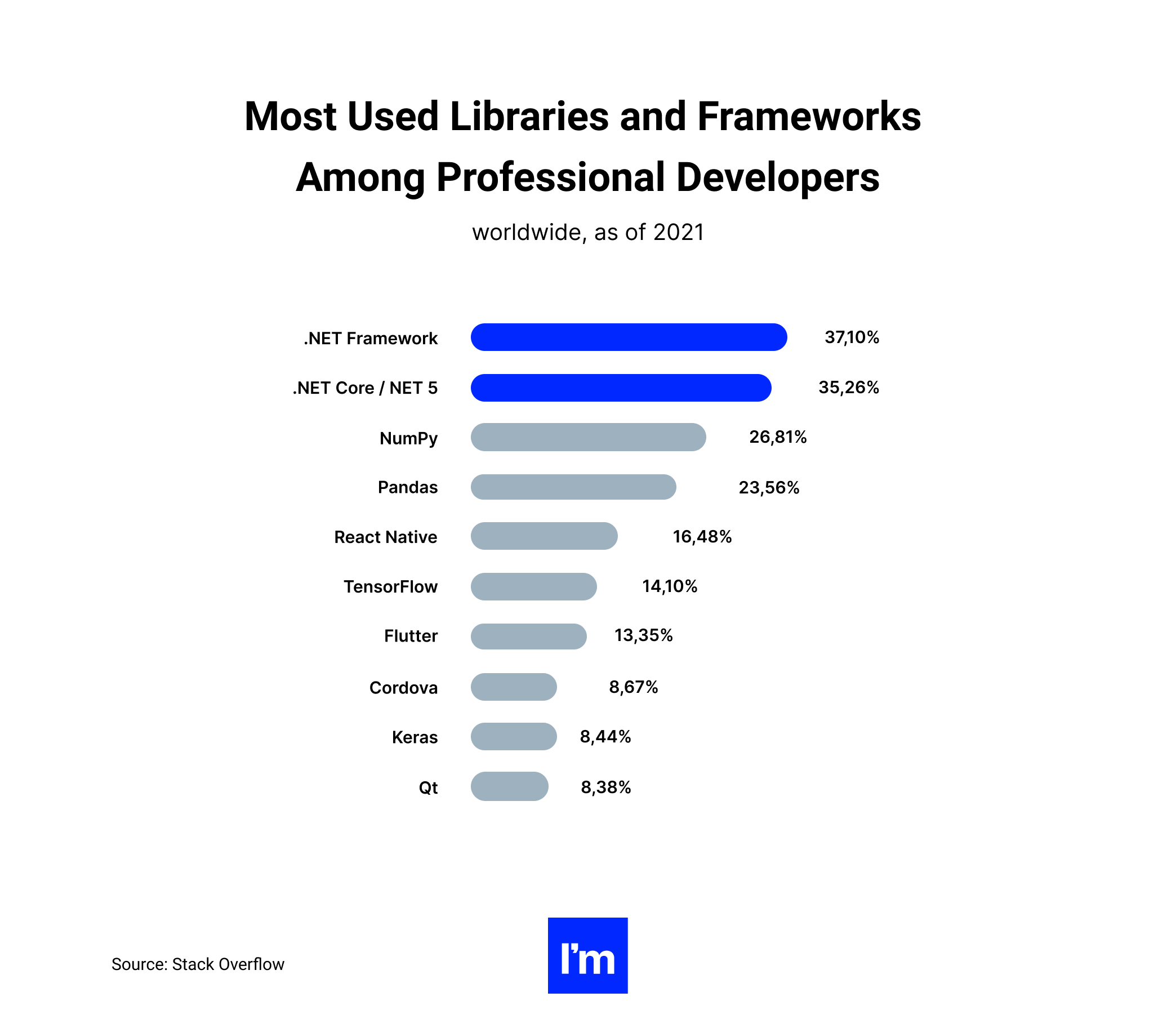
What .NET-related events are out there?
.NET Conf
.NET Conf is a free three-day virtual developer event dedicated to the major releases of the .NET Development Platform. It is hosted by the .NET community and Microsoft and sponsored by the .NET Foundation and the ecosystem partners.
Microsoft Inspire
The new event, formerly known as Microsoft's Worldwide Partner Conference, offers a week full of communication, learning, and collaboration for current Microsoft partners and those interested in forging partnerships with the tech giant.
At Microsoft Inspire, you can hear the latest insights from top Microsoft executives, meet with other Microsoft partners, and gain many opportunities to accelerate your success. Simply put, there is no other event that offers the same quality of Microsoft partner experience as Microsoft Inspire.
Visual Studio Live!
VSLive! organizes a series of independent conferences beginning in June and ending in November. The campaign includes five events that are held in different cities in the United States. There, software developers have the opportunity to improve their skills in Visual Studio, ASP.NET, .NET Core, ASP.NET Core security, JavaScript, Xamarin, Database Analytics, and other technologies.
Microsoft Ignite
Formerly known as TechEd, this conference is a place where big thinkers from the IT industry flock to network with tech leaders and peers and get the latest insights from technology giants and practitioners in the cloud, data, business intelligence, teamwork, and productivity fields.
Top Java events and influencers to follow
As software development is highly collaborative, social media has become a hub for grassroots software development communities. LinkedIn, Facebook, and especially Twitter and Reddit provide platforms for Java professionals and enthusiasts to connect, collaborate, and share insights on Java software development.
Over the years, some Java experts have built a significant following - their accounts are go-to places for the latest Java news and updates, events coverage, and groundbreaking innovation. Here are a few leading Java experts to watch on social media.

By day, Markus is a Developer Adoption Program Lead in EMEA at Red Hat. Off duty, he’s also a Java Champion, former Java EE Expert Group member, founder of JavaLand, and a reputed speaker at Java conferences (see below), with over 14 years of solid experience as a Java EE developer and expert. You can follow him for updates on Java development and microservices architecture.

The Deputy CTO of Azul Systems, Simon has been with Sun Microsystems, then Oracle, for nearly 20 years, leading the Java technology evangelism team and driving adoption of the language across different sectors. In his own words, Simon is spreading the word on Java and JVM, far and wide.

Trisha is a Lead Developer Advocate at JetBrains with expertise in Java high-performance systems and software applications for a range of industries. She’s focused on making Java programmers’ lives easier through her blog posts, books, speeches, and a monthly newsletter at JetBrains. Trisha shares time-saving tips and tricks for developers and insights on improving one’s Java skills.

Adam has been working as a freelance Java consultant since JDK 1.0, and over the years, he has evolved into one of the leading Java experts. A Java Champion, NetBeans Dream Team Founding Member, Oracle ACE Director, triple JavaOne Rock Star, he is a regular speaker at Java conferences. He also has a blog, podcast, and YouTube channel - all related to Java programming.

Mark is the Chief Architect of the Java Platform Group at Oracle. He has contributed to the development of the Java SE Platform for over 20 years, serving as lead engineer for several JDK releases. Mark’s Twitter account is a reliable source of knowledge about the upcoming Java releases and updates.

Josh is an application developer, technical writer, and DB administrator who primarily works with Java and other JVM technologies. He is a prolific writer sharing his insights and expertise on Java software development and a frequent contributor to Oracle blog and Java Magazine. Follow him on Java-related technical content, news, and events coverage.

Apart from being a Java Champion, international keynote speaker, and IBM Master Inventor, Angie volunteers with Black Girls Code and runs her blog, sharing loads of programming and automation articles, videos, and other content. Angie also leads an online training platform, Test Automation University.

Previously with Oracle for nearly six years as Principal Product Manager, Bruno now works in Microsoft’s Developer Division Java Engineering Group. He’s responsible for building Java workloads for Azure cloud while also leading Java at Microsoft public communications. So if you want any updates on Java EE, cloud computing, and JavaFX, his account is the place to go.

Another Java Champion on our list, Mala works as a Developer Advocate for JetBrains. She is also an author of several OCA Java Certification Guides and other Java programming-related books, a keynote speaker, and the founder of a website that offers courses for Oracle Java certifications. Check out her tweets for Java event updates, technical insights, and educational resources.
.NET influencers/blogs/podcasts to follow
Mike’s Dot Netting

Mikesdotnetting.com covers all aspects of ASP.NET and is authored by Mike Brind, a longtime Microsoft MVP for ASP/ASP.NET. If your goal is to keep up with the latest ASP.NET features, Mike is the guy to listen to. He's been spending a lot of time lately covering new updates to the Razor page.
Areas covered:
- ASP.NET
- Razor Pages
- ASP classic
You’ve Been Haacked

Is it some kind of coincidence that someone named Haack became a programmer? Phil Haack works at Github and has been blogging since 2004. In addition to his interests in Git and .NET, Phil is passionate about open source projects. He also writes about leadership and management in the tech world.
Areas covered:
- Git
- ASP.NET
- .NET Core
- Leadership
Maarten Balliauw

Maarten Balliauw is a speaker, programmer, and technology advocate at JetBrains. He writes frequently on the road, speaking at conferences around the world, talking about lessons learned and the latest technical innovations.
Areas covered:
- ASP.NET MVC
- C#
- Microsoft Azure
- PHP
Code Opinion

Code Opinion is written by Derek Cromartin, Microsoft Visual Studio, and MVP Development Specialist. CodeOpinion is ideal for ASP.NET developers interested in architectural patterns such as CQRS and Event-Driven, and the development of HTTP API. He covers these and many other topics on his blog as well as on his Youtube channel.
Areas covered:
- .NET Core
- CQRS
- ASP.NET
Matt Warren

Matt Warren is a regular speaker and blogger covering .NET, CLR, and C#. His blog is great for .NET developers who are especially interested in how the CLR and CoreCLR work. Matt's article "Hitchhiker’s Guide to the CoreCLR Source Code" is a must-read for rookie devs.
Areas covered:
- CLR
- Core CLR
- C#
- .NET
.NET Rocks

Carl and Richard get together every week and invite a new guest to the podcast, which provides many interesting views and specific areas to discuss.
Areas covered:
- .NET Core
- Azure
- Cloud
- ASP.NET
Merge Conflict

The co-authors are big fans of the .NET platform and Microsoft development in general. Frank and James release a new episode every week and talk in a casual manner, but always have a clear goal for the episode.
Areas covered:
- Azure
- C#
- DevOps
- .NET Core
Future plans
Since .NET 5 did not implement all planned features due to some technical issues as well as delays caused by the COVID-19 pandemic, some of the original plans for .NET 5 have been ported to .NET 6 (expected November 2021), which will be a Long Term Support (LTS) release. We can see .NET 5 as the next step towards the bright future of .NET.
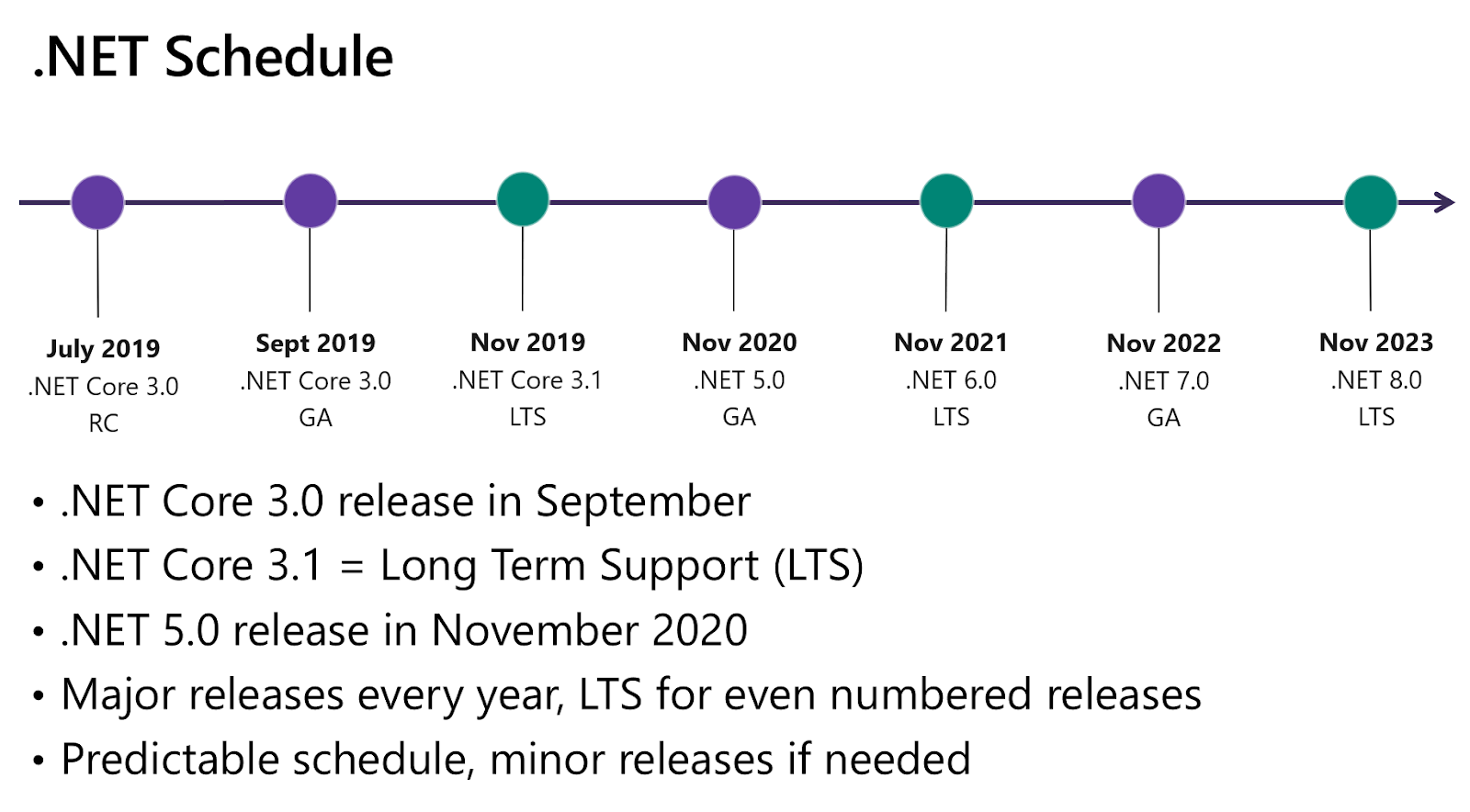
The most important targets for .NET 6 are already set. Many of these focus on improvements that were not included in .NET 5, such as next-generation Xamarin, which lowers the barriers between desktop and native mobile development, and better integration between many different sets of Windows UI toolkits.
.NET 5 is a key technology for separating the Windows API from the OS, merging WinRT and Win32 APIs in Project Reunion, and moving to WinUI 3 and MAUI as UI layers. The Windows team continues to work on Project Reunion as the next step forward for the UWP and related technologies.
In 2020, Microsoft announced the release of a new premium UI framework for building cross-platform applications called .NET MAUI. It will be an evolution of Xamarin.Forms that will simplify the developer workflow and project structure into a single project targeting multiple platforms. .NET MAUI will be released to the public with .NET 6 in November 2021.
On the new website created by Microsoft, we can see the vision for .NET. This is called Themes of .NET. First published late last year, themesof.net collects GitHub issues and aggregates them into themes and epics (terminology associated with Agile project management). On this site, we can see that Microsoft will prioritize the following topics:
Making .NET accessible for beginners and educators
The idea is to lower the barriers to entry for .NET in the form of an open-source computer science curriculum that can be run interactively on .NET laptops.
Blazor to your desktop
This would be an interesting direction and probably a competitor to Electron. Extending the reach of Blazor is the official goal and looks like a good move.
Improving the .NET ecosystem
The idea is as follows:
Many developers avoid third-party tools when building their .NET development stack ➡️ As .NET continues to grow ➡️ it should help other developers succeed, especially those with open source projects that the whole community can use.
Better development performance
This includes long-awaited enhancements such as hot reloading in ASP.NET and pre-compilation for Blazor. Microsoft claims that in this area, competing platforms are still supplanting .NET.
Democratize ML.NET
The gap between toy examples in ML.NET (introduced in 2018) and practical integration is huge, and many developers fall off the chasm in a moment of enthusiasm. Microsoft developers have come up with many small improvements that can help non-experts integrate machine learning functionality into their applications.
So, looking at the latest trends, including Azure as one of the main cloud platforms, the future of the Microsoft developer world looks great. Given that open source and cross-platform are key priorities, it seems like it will move in the right direction in the years to come.
09 Wrap-up
Seems like you reached the end. Well done! Hope you didn’t miss any part since they are all crucial for the final perception of the technology.
Thank you for being with us throughout this article!
Hopefully, by now your understanding of .NET has deepened a lot, and maybe you'll even start to love it (as we do!).
We made every effort to cover all important areas related to .NET. But we know that with technology’s growth, this page will also need to grow. That's why you can count on us to continually update and develop content to keep it up-to-date and provide the best possible information.
As for now, please, help us spread this valuable info by sharing and reposting the piece.
Ideamotive Team
Ready to build your next digital product with .NET?
We run a vast network of vetted software development professionals, including .NET experts. We can provide you with technical consultancy, add devs to your existing team or assemble one from scratch.
Rated 4.8 / 5.0 by clients from various industries and locations.
